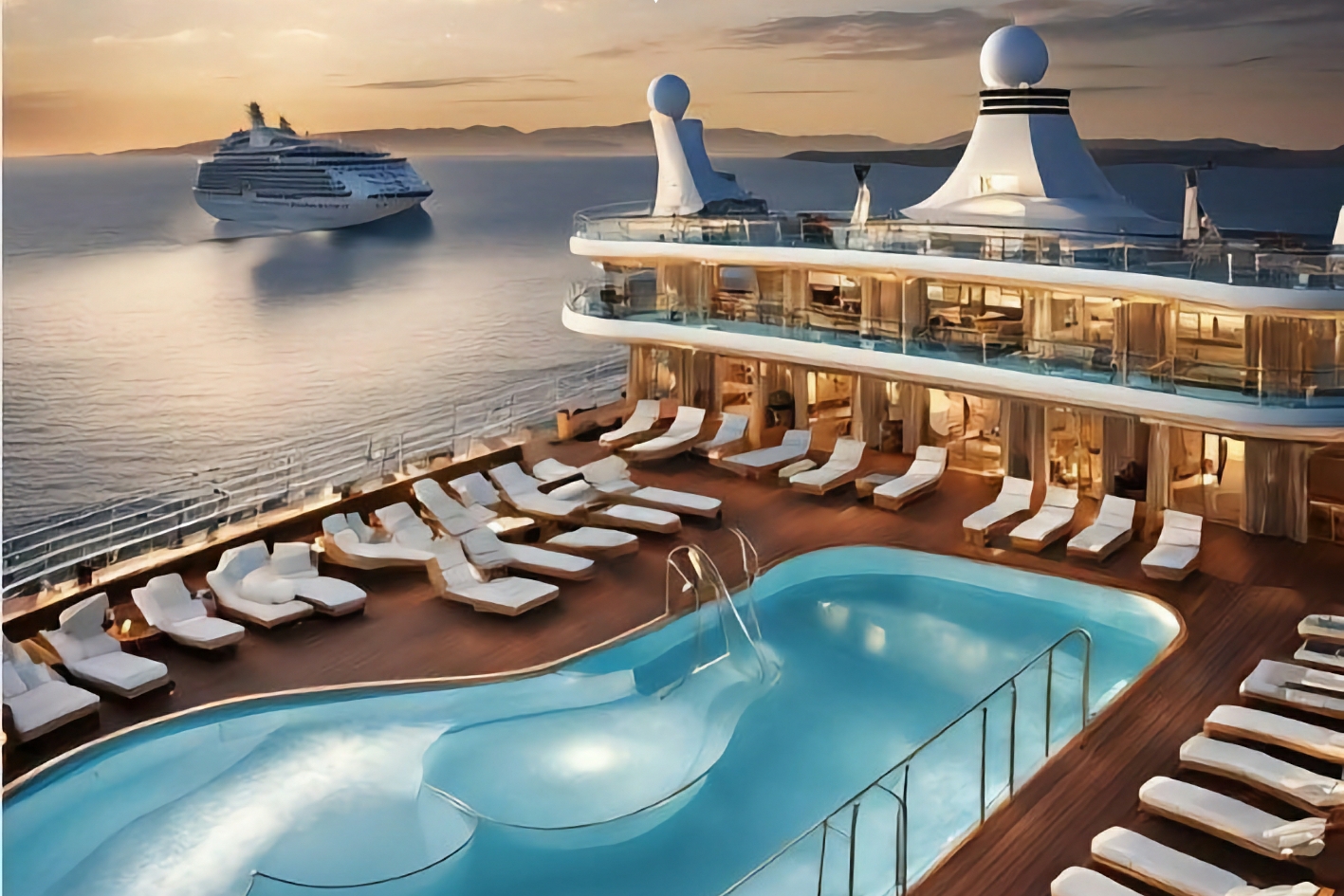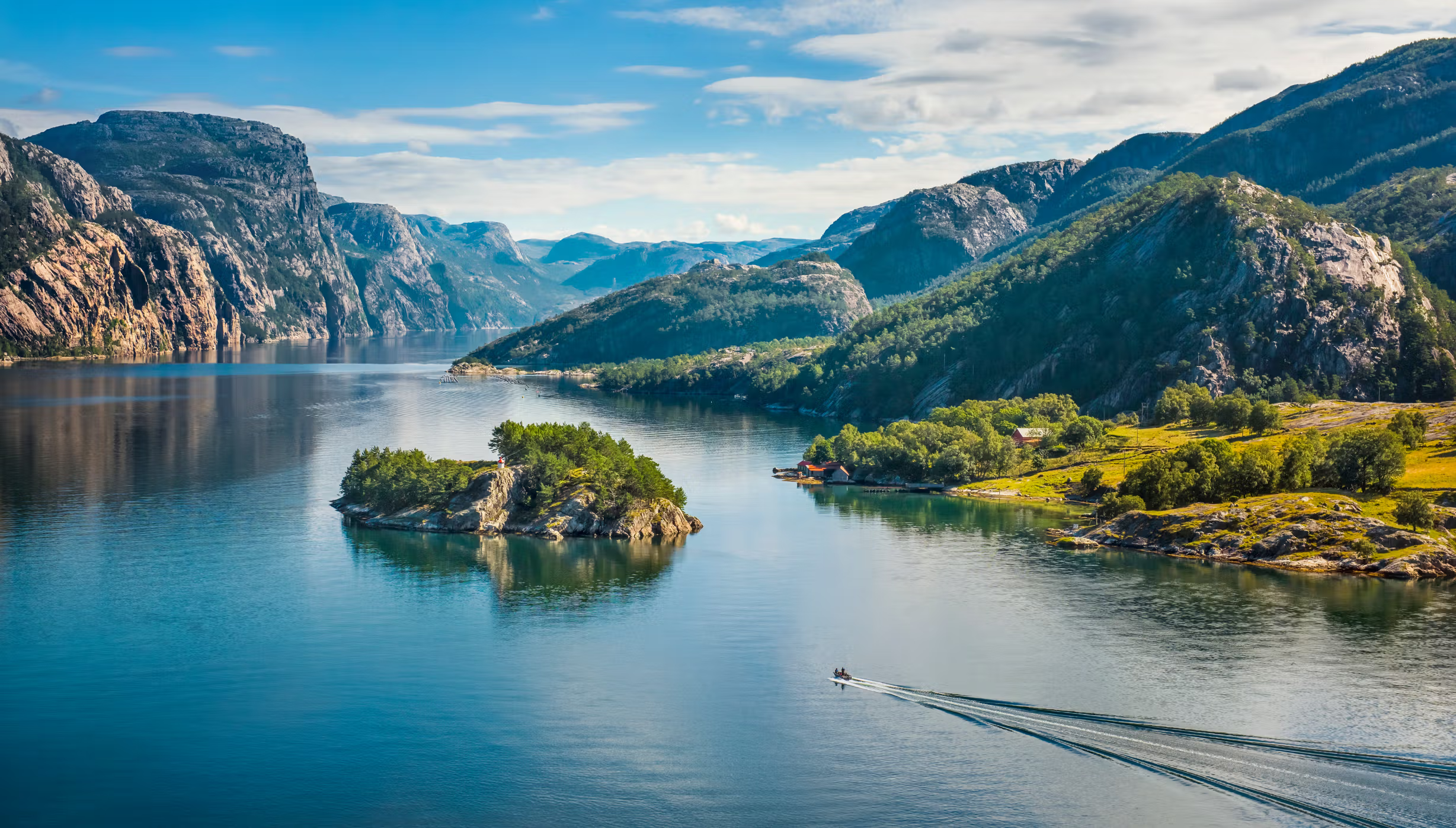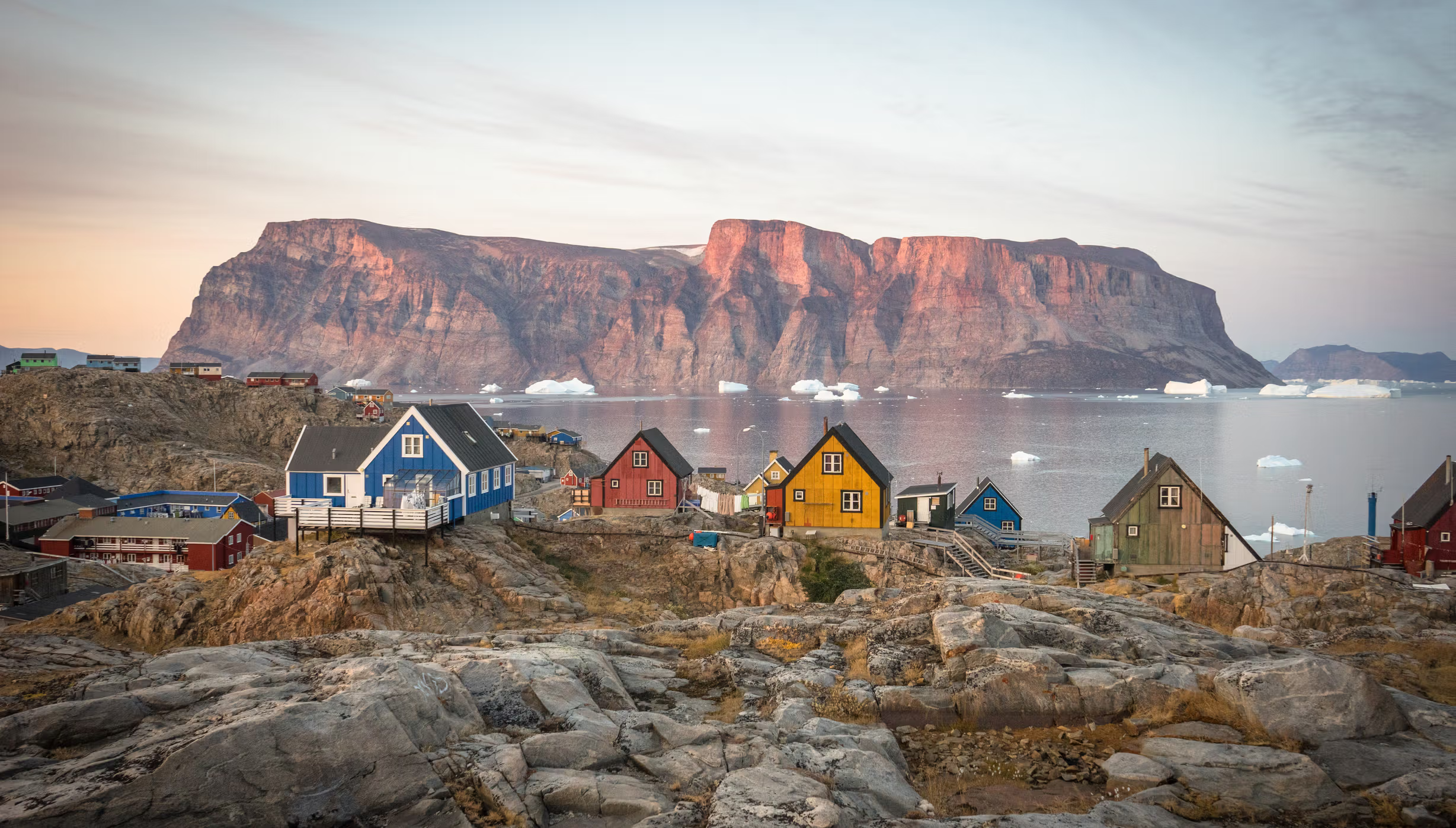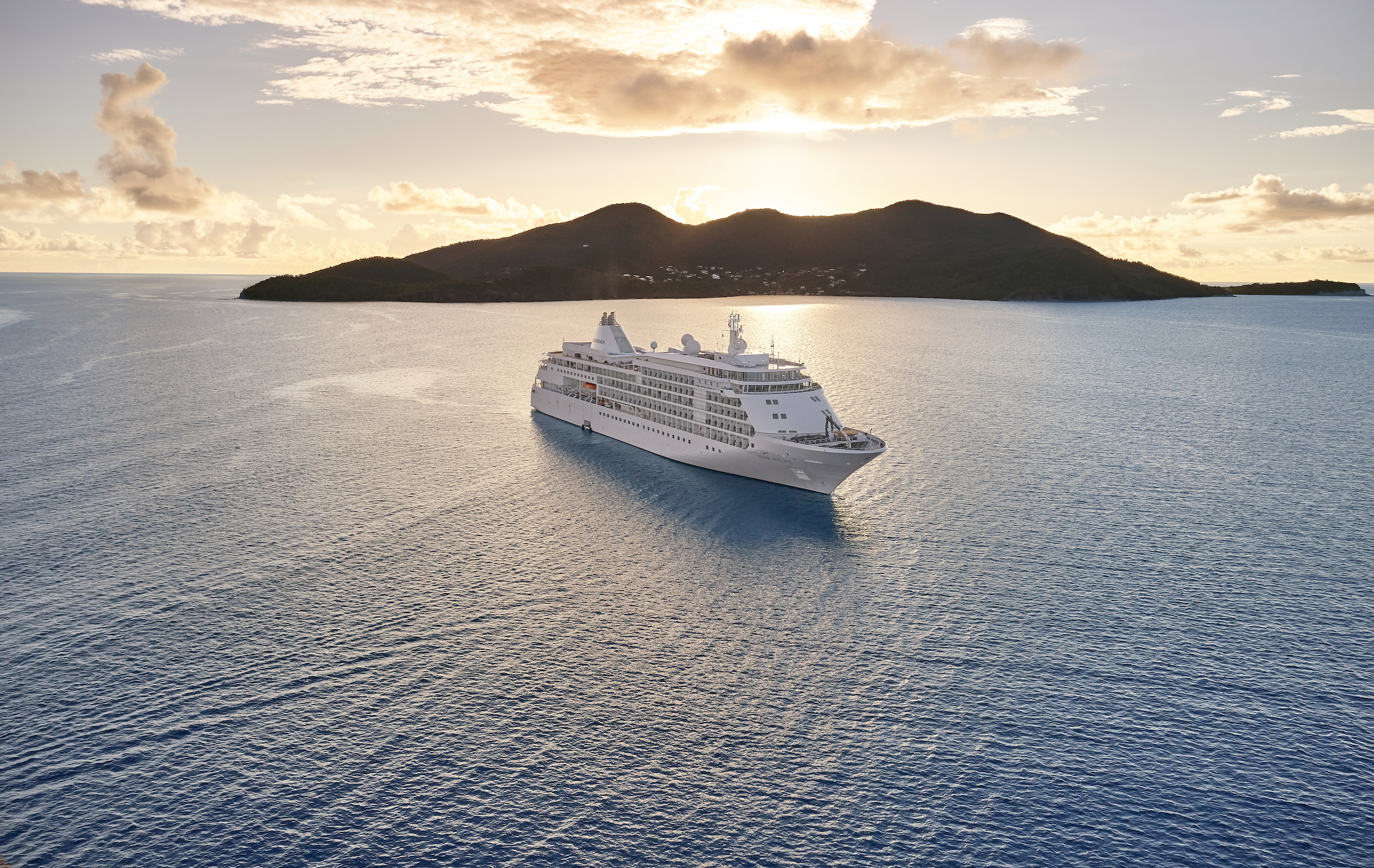Itinerary
It’s no wonder that all roads lead to the fascinating and maddening metropolis of Athens. Lift your eyes 200 feet above the city to the Parthenon, its honey-color marble columns rising from a massive limestone base, and you behold architectural perfection that has not been surpassed in 2,500 years. But, today, this shrine of classical form dominates a 21st-century boomtown. To experience Athens—Athína in Greek—fully is to understand the essence of Greece: ancient monuments surviving in a sea of cement, startling beauty amid the squalor, tradition juxtaposed with modernity. Locals depend on humor and flexibility to deal with the chaos; you should do the same. The rewards are immense. Although Athens covers a huge area, the major landmarks of the ancient Greek, Roman, and Byzantine periods are close to the modern city center. You can easily walk from the Acropolis to many other key sites, taking time to browse in shops and relax in cafés and tavernas along the way. From many quarters of the city you can glimpse “the glory that was Greece” in the form of the Acropolis looming above the horizon, but only by actually climbing that rocky precipice can you feel the impact of the ancient settlement. The Acropolis and Filopappou, two craggy hills sitting side by side; the ancient Agora (marketplace); and Kerameikos, the first cemetery, form the core of ancient and Roman Athens. Along the Unification of Archaeological Sites promenade, you can follow stone-paved, tree-lined walkways from site to site, undisturbed by traffic. Cars have also been banned or reduced in other streets in the historical center. In the National Archaeological Museum, vast numbers of artifacts illustrate the many millennia of Greek civilization; smaller museums such as the Goulandris Museum of Cycladic Art Museum and the Byzantine and Christian Museum illuminate the history of particular regions or periods. Athens may seem like one huge city, but it is really a conglomeration of neighborhoods with distinctive characters. The Eastern influences that prevailed during the 400-year rule of the Ottoman Empire are still evident in Monastiraki, the bazaar area near the foot of the Acropolis. On the northern slope of the Acropolis, stroll through Plaka (if possible by moonlight), an area of tranquil streets lined with renovated mansions, to get the flavor of the 19th-century’s gracious lifestyle. The narrow lanes of Anafiotika, a section of Plaka, thread past tiny churches and small, color-washed houses with wooden upper stories, recalling a Cycladic island village. In this maze of winding streets, vestiges of the older city are everywhere: crumbling stairways lined with festive tavernas; dank cellars filled with wine vats; occasionally a court or diminutive garden, enclosed within high walls and filled with magnolia trees and the flaming trumpet-shaped flowers of hibiscus bushes. Formerly run-down old quarters, such as Thission, Gazi and Psirri, popular nightlife areas filled with bars and mezedopoleia (similar to tapas bars), are now in the process of gentrification, although they still retain much of their original charm, as does the colorful produce and meat market on Athinas. The area around Syntagma Square, the tourist hub, and Omonia Square, the commercial heart of the city about 1 km (½ mi) northwest, is distinctly European, having been designed by the court architects of King Otho, a Bavarian, in the 19th century. The chic shops and bistros of ritzy Kolonaki nestle at the foot of Mt. Lycabettus, Athens’s highest hill (909 feet). Each of Athens’s outlying suburbs has a distinctive character: in the north is wealthy, tree-lined Kifissia, once a summer resort for aristocratic Athenians, and in the south and southeast lie Glyfada, Voula, and Vouliagmeni, with their sandy beaches, seaside bars, and lively summer nightlife. Just beyond the city’s southern fringes is Piraeus, a bustling port city of waterside fish tavernas and Saronic Gulf views.
Day itinerary:
A city of legend, civilisation and enduring culture, Athens is a majestic and magical urban sprawl. Extraordinary elegance and grace combine with grit and graft in Greece’s capital, where highways encase ruins from antiquity, and gleaming museums and galleries stand beside concrete sprayed with edgy street art. These contrasts enhance and elevate the wonders of this 2,500-year-old city, however, which can count notable contributions to philosophy, drama and democracy, among its global legacy. Piraeus’ giant port and naval base welcome you to the edge of the Athens’ urban area. From there it’s a simple jaunt to the centre. The majestic ancient citadel of the Acropolis dominates an elevated platform and is a constant presence as you explore the city. The wonderful remains of the columned temple of the Parthenon – which date back to the 5th century BC – stand here, representing the pinnacle of classical architecture. The nearby Acropolis Museum adds context to your visit and frames the broad views from its giant glass windows. Or rise up Mount Lycabettus, to be rewarded with perhaps Athens’ best panorama of the Acropolis sitting high over the city on its grand stage. See the marble horseshoe of the Old Olympic Stadium, where the first modern Olympics were held in 1896, for more of the city’s enduring legacy. Elsewhere, golden beaches and temples stretch out along the coastline, should you wish to explore a little further afield. Coffee is an art form to the Greeks, and it’s an unwritten rule that coffee time must never be rushed. So prepare to settle down for a couple of hours and lose yourself in a good chat. Feeling hungry – try traditional souvlaki made with sauces handed from generation to generation.
Undoubtedly the most extraordinary island in the Aegean, crescent-shape Santorini remains a mandatory stop on the Cycladic tourist route—even if it’s necessary to enjoy the sensational sunsets from Ia, the fascinating excavations, and the dazzling white towns with a million other travelers. Called Kállisti (the “Loveliest”) when first settled, the island has now reverted to its subsequent name of Thira, after the 9th-century-BC Dorian colonizer Thiras. The place is better known, however, these days as Santorini, a name derived from its patroness, St. Irene of Thessaloniki, the Byzantine empress who restored icons to Orthodoxy and died in 802. You can fly conveniently to Santorini, but to enjoy a true Santorini rite of passage, opt instead for the boat trip here, which provides a spectacular introduction. After the boat sails between Sikinos and Ios, your deck-side perch approaches two close islands with a passage between them. The bigger one on the left is Santorini, and the smaller on the right is Thirassia. Passing between them, you see the village of Ia adorning Santorini’s northernmost cliff like a white geometric beehive. You are in the caldera (volcanic crater), one of the world’s truly breathtaking sights: a demilune of cliffs rising 1,100 feet, with the white clusters of the towns of Fira and Ia perched along the top. The bay, once the high center of the island, is 1,300 feet in some places, so deep that when boats dock in Santorini’s shabby little port of Athinios, they do not drop anchor. The encircling cliffs are the ancient rim of a still-active volcano, and you are sailing east across its flooded caldera. On your right are the Burnt isles, the White isle, and other volcanic remnants, all lined up as if some outsize display in a geology museum. Hephaestus’s subterranean fires smolder still—the volcano erupted in 198 BC, about 735, and there was an earthquake in 1956. Indeed, Santorini and its four neighboring islets are the fragmentary remains of a larger landmass that exploded about 1600 BC: the volcano’s core blew sky high, and the sea rushed into the abyss to create the great bay, which measures 10 km by 7 km (6 mi by 4½ mi) and is 1,292 feet deep. The other pieces of the rim, which broke off in later eruptions, are Thirassia, where a few hundred people live, and deserted little Aspronissi (“White isle”). In the center of the bay, black and uninhabited, two cones, the Burnt Isles of Palea Kameni and Nea Kameni, appeared between 1573 and 1925. There has been too much speculation about the identification of Santorini with the mythical Atlantis, mentioned in Egyptian papyri and by Plato (who says it’s in the Atlantic), but myths are hard to pin down. This is not true of old arguments about whether tidal waves from Santorini’s cataclysmic explosion destroyed Minoan civilization on Crete, 113 km (70 mi) away. The latest carbon-dating evidence, which points to a few years before 1600 BC for the eruption, clearly indicates that the Minoans outlasted the eruption by a couple of hundred years, but most probably in a weakened state. In fact, the island still endures hardships: since antiquity, Santorini has depended on rain collected in cisterns for drinking and irrigating—the well water is often brackish—and the serious shortage is alleviated by the importation of water. However, the volcanic soil also yields riches: small, intense tomatoes with tough skins used for tomato paste (good restaurants here serve them); the famous Santorini fava beans, which have a light, fresh taste; barley; wheat; and white-skin eggplants.
Day itinerary:
Breathlessly romantic and incredibly scenic the azure domes and whitewash buildings that cascade down Santorini’s slopes are prime honeymoon material – and relentlessly romantic. A true gem of the Cycladic island group Santorini is startlingly pretty and its white windmills and dazzling villages are incredibly easy on the eye. Envy-inducing and evocatively beautiful Santorini’s sunsets are legendary and the island is a highlight of any voyage to the Greek islands. Look out over the endless expanse of blue waves filling the massive volcanic caldera of Santorini – and absorb one of the most spectacular views in the world. The sheer rock shoulders of the caldera create an immense natural amphitheatre – so enjoy the show as you sip a local volcanic-mineral enhanced white wine and fall in love all over again. Any meal is well rounded off with the famous wine Vinsanto. The east side of the island may lack the incredible panoramas but it’s ideal if all you want to do is recline on volcanic-sand beaches – which range in hues from charcoal-black to flame-red. This beautiful island was forged by powerful volcanic activity and you can learn more about the huge eruption of 1 600 BCE – which wiped out the Minoan city at Akrotiri. The eruption sank the centre of the island forming the moon-shaped topography we see now. Visit the archaeological site that has revealed and preserved the village which was lost to time below the pumice and ash. Some whisper that this destroyed town may even be the fabled Atlantis.
Day itinerary:
Spread out between two crescent bays, Bodrum exudes an “artsy” ambiance. With its gleaming white houses and colorful flower gardens it is one of the prettiest resorts on the South Aegean coast. Recently, it has become very popular with the jet set crowd, while at the same time maintaining an intimate air; there are strict zoning laws preventing over development. Bodrum’s main draws are pristine beaches, a busy yachting center and historic sites – a great combination to attract those sailing the Aegean Sea. Bodrum was known in antiquity as the site of Halicarnassus, a city whose origin dates back as far as 1000 BC. It was known for its splendid mausoleum, an enormous white marble tomb that King Mausolus had planned for himself. It was one of the Seven Wonders of the Ancient World. Although the structure was obliterated by the ravages of time, archaeologists have arranged models and drawings at the site to provide an idea of what the mausoleum looked like. Bodrum was also the birthplace of Herodotus, who wrote the first comprehensive world history. Today’s major cultural attraction is the massive Castle of St. Peter.
For better or worse, it can be difficult to reach Patmos—for many travelers, this lack of access is definitely for the better, since the island retains the air of an unspoiled retreat. Rocky and barren, the small, 34-square-km (21-square-mi) island lies beyond the islands of Kalymnos and Leros, northwest of Kos. Here on a hillside is the Monastery of the Apocalypse, which enshrines the cave where St. John received the Revelation in AD 95. Scattered evidence of Mycenaean presence remains on Patmos, and walls of the classical period indicate the existence of a town near Skala. Most of the island’s approximately 2,800 people live in three villages: Skala, medieval Chora, and the small rural settlement of Kambos. The island is popular among the faithful making pilgrimages to the monastery as well as with vacationing Athenians and a newly growing community of international trendsetters—designers, artists, poets, and “taste gurus” (to quote Vogue’s July 2011 write-up of the island)—who have bought homes in Chora. These stylemeisters followed in the footsteps of Alexandrian John Stefanidis and the English artist Teddy Millington-Drake who, in the early ’60s, set about creating what eventually became hailed as one of the most gorgeous island homes in the world. The word soon spread thanks to their many guests (who included Jacqueline Kennedy Onassis) but, happily, administrators have carefully contained development, and as a result, Patmos retains its charm and natural beauty—even in the busy month of August.
Day itinerary:
The seahorse-shaped Patmos is a Greek island of stunning seascapes and immense cultural significance. Whether you’re religious or not there is something of the divine in this gorgeous island – a place of sanctuary fringed by crystal-clear waters and blissful beaches. Sleepy whitewash towns gleam in the strong sunshine while cats slink between the crumbling walls of this ruggedly beautiful island. High on the hillside above the cobalt-blue bay you’ll find the sacred chapel where an exiled John of Patmos is said to have entered the Cave of the Apocalypse and prophesied of the end of the world’s fire and brimstone – a striking juxtaposition with the peaceful serenity of the calm location. Higher up you’ll find the 11th-century Monastery of St. John which offers spectacular views of the island’s mounds curving around like a scorpion’s tail. It stands watching over the island like a fortified crown. Sun-wrinkled black-robed monks climb the streets up to this World Heritage site where bells peel out melodically. Inside vaulted chambers and stunning frescoes tell stories amid the striking religious iconography. Chora’s incredible narrow streets – moulded white – are an enchanting place to lose your bearings spreading below the monastery. Elsewhere blissful beaches stretch out across the coastline or this remote Greek island’s curves can be admired while bobbing offshore in a sailboat.
Syros is an island in the Aegean Sea, 78 miles (125 kilometres) southeast of Athens, and the administrative, commercial, intellectual and cultural centre of the Cyclades. Syros is 32 square miles (82.8 square kilometres) in area. Its largest towns are Ermoupoli, the capital of the island and Cyclades, Ano Syros and Vari. Although Syros belongs to the Cyclades islands, its architecture is more medieval than Cycladic. The beaches of Syros are especially inviting, and surrounded by many tourist facilities and accommodations.
Day itinerary:
Beautiful sea crisp white beaches and charming medieval villages add character and colour to this gorgeous Greek Island. Part of the Cyclades group of islands visit the capital Ermoupoli to discover a network of picturesque narrow streets and winding alleyways – dotted with fancy old Venetian mansions and elegant domed churches. The colourful town cascades down to an open waterfront of pine-trees and beautiful views. Head to the sparkling marbled central square overlooked by the Town Hall and surrounded by a celebrated collection of neoclassical buildings facing up across narrow streets. A town of peeking bell towers and cobalt-blue domed churches – stop by the Church of the Assumption which treasures an original El Greco wonder inside. Further up you’ll find the small monastery-sprinkled medieval village of Ano Syros. Settled on a hill it offers a glorious view down over the port and white dwellings of Ermoupoli below. You can visit Capuchin Monastery which was built in the 16th century to help the underprivileged. Encounter the Vamvakaris Museum dedicated to Markos Vamvakaris a famous rebetiko musician born here in 1905. Of course Syros is also surrounded by plenty of blissful beaches if you’d rather hit the sands. Finikas beach is nearby and a long luxurious stretch complete with sunbeds and umbrellas. Perfect for catching some sun and shade and watching the blue seawater twinkling.
Milos or Melos is a volcanic Greek island in the Aegean Sea, just north of the Sea of Crete. Milos is the southwesternmost island in the Cyclades group. The Venus de Milo and the Asclepius of Milos were both found on the island, as were a Poseidon and an archaic Apollo now in Athens.
Day itinerary:
Milos, one of the thousands of Greek islands, is to be found in the SW Cyclades, a large island group in the Aegean Sea. It is 86 nautical miles from Piraeus and approximately half way between Piraeus and Crete. Its surface area is 151 square kilometres and its varied coastline is 125 kilometres long. Adamas is the main port of Milos and also a seaside village of white houses shimmering on the blue waters of the Aegean. This village was founded in 1835 by refugees from Sfakia who came from Crete after the failure of their rebellion against the Turks From these times and on, Adamas became increasingly important historically because of its large, safe, naturally made harbour, and its strategic position in the eastern Mediterranean Adamas is surrounded by many beaches and offers various touristy facilities such as banks, post-office, doctors, tourist agencies, port police. Many old churches as well as mining and ecclesiastical museums are worth visiting.
Rethymnon is Crete’s third-largest town, after Heraklion and Hania. The population (about 30,000) steadily increases as the town expands—a new quarter follows the coast to the east of the Old Town, where the beachfront has been tastelessly developed with large hotels and other resort facilities catering to tourists on package vacations. However, much of Rethymnon’s charm perseveres in the old Venetian quarter, which is crowded onto a compact peninsula dominated by the huge, fortified Venetian castle known as the Fortezza. Wandering through the narrow alleyways, you come across handsome carved-stone Renaissance doorways belonging to vanished mansions, fountains, archways, and wooden Turkish houses with latticework screens on the balconies to protect the women of the house from prying eyes.
Day itinerary:
A romantic arrival below honey-coloured Venetian fortifications welcomes you to the historic heart of Rethymnon. Sandwiched between the sprawling city of Heraklion and the pretty old town of Chania Rethymnon offers history and gorgeous swathes of wide sandy beaches. Delve into the area’s heritage beauty and mythology – surrounded by legendary caves where Zeus is said to have lived monasteries that perch on mountain slopes and gorges that slice through dramatic island scenery. Hours slide past at the beautiful Venetian harbour where coffee cups are cradled and conversations linger in the sun as occasional fishing boats bob by. Rethymnon is one of Crete’s prettiest places and wandering the old town soaking in the charm is a day well spent. Stop off at ivy-tangled cafes in hidden courtyards and admire colourful ornate doorways. Wander to the sparkling water of Rimondi fountain which has quenched the thirst of locals since 1626. To the east Rethymno Beach unravels with well-maintained facilities and plenty of room to relax or swim in the warm Aegean’s embrace. Episkopi Beach is another leisurely option unwinding to the west. Outside of Rethymnon farms cultivate olives and grapes on the sunned slopes – best enjoyed with freshly baked bread and a selection of sheep’s cheese. A splash of local raki – a moreish brandy shot – will also go down a treat. Or dig deep into Crete’s rich archaeological past and Minoan history at Knossos’s ancient city and the world-class Heraklion’s Archaeological Museum.
It’s no wonder that all roads lead to the fascinating and maddening metropolis of Athens. Lift your eyes 200 feet above the city to the Parthenon, its honey-color marble columns rising from a massive limestone base, and you behold architectural perfection that has not been surpassed in 2,500 years. But, today, this shrine of classical form dominates a 21st-century boomtown. To experience Athens—Athína in Greek—fully is to understand the essence of Greece: ancient monuments surviving in a sea of cement, startling beauty amid the squalor, tradition juxtaposed with modernity. Locals depend on humor and flexibility to deal with the chaos; you should do the same. The rewards are immense. Although Athens covers a huge area, the major landmarks of the ancient Greek, Roman, and Byzantine periods are close to the modern city center. You can easily walk from the Acropolis to many other key sites, taking time to browse in shops and relax in cafés and tavernas along the way. From many quarters of the city you can glimpse “the glory that was Greece” in the form of the Acropolis looming above the horizon, but only by actually climbing that rocky precipice can you feel the impact of the ancient settlement. The Acropolis and Filopappou, two craggy hills sitting side by side; the ancient Agora (marketplace); and Kerameikos, the first cemetery, form the core of ancient and Roman Athens. Along the Unification of Archaeological Sites promenade, you can follow stone-paved, tree-lined walkways from site to site, undisturbed by traffic. Cars have also been banned or reduced in other streets in the historical center. In the National Archaeological Museum, vast numbers of artifacts illustrate the many millennia of Greek civilization; smaller museums such as the Goulandris Museum of Cycladic Art Museum and the Byzantine and Christian Museum illuminate the history of particular regions or periods. Athens may seem like one huge city, but it is really a conglomeration of neighborhoods with distinctive characters. The Eastern influences that prevailed during the 400-year rule of the Ottoman Empire are still evident in Monastiraki, the bazaar area near the foot of the Acropolis. On the northern slope of the Acropolis, stroll through Plaka (if possible by moonlight), an area of tranquil streets lined with renovated mansions, to get the flavor of the 19th-century’s gracious lifestyle. The narrow lanes of Anafiotika, a section of Plaka, thread past tiny churches and small, color-washed houses with wooden upper stories, recalling a Cycladic island village. In this maze of winding streets, vestiges of the older city are everywhere: crumbling stairways lined with festive tavernas; dank cellars filled with wine vats; occasionally a court or diminutive garden, enclosed within high walls and filled with magnolia trees and the flaming trumpet-shaped flowers of hibiscus bushes. Formerly run-down old quarters, such as Thission, Gazi and Psirri, popular nightlife areas filled with bars and mezedopoleia (similar to tapas bars), are now in the process of gentrification, although they still retain much of their original charm, as does the colorful produce and meat market on Athinas. The area around Syntagma Square, the tourist hub, and Omonia Square, the commercial heart of the city about 1 km (½ mi) northwest, is distinctly European, having been designed by the court architects of King Otho, a Bavarian, in the 19th century. The chic shops and bistros of ritzy Kolonaki nestle at the foot of Mt. Lycabettus, Athens’s highest hill (909 feet). Each of Athens’s outlying suburbs has a distinctive character: in the north is wealthy, tree-lined Kifissia, once a summer resort for aristocratic Athenians, and in the south and southeast lie Glyfada, Voula, and Vouliagmeni, with their sandy beaches, seaside bars, and lively summer nightlife. Just beyond the city’s southern fringes is Piraeus, a bustling port city of waterside fish tavernas and Saronic Gulf views.
Day itinerary:
A city of legend, civilisation and enduring culture, Athens is a majestic and magical urban sprawl. Extraordinary elegance and grace combine with grit and graft in Greece’s capital, where highways encase ruins from antiquity, and gleaming museums and galleries stand beside concrete sprayed with edgy street art. These contrasts enhance and elevate the wonders of this 2,500-year-old city, however, which can count notable contributions to philosophy, drama and democracy, among its global legacy. Piraeus’ giant port and naval base welcome you to the edge of the Athens’ urban area. From there it’s a simple jaunt to the centre. The majestic ancient citadel of the Acropolis dominates an elevated platform and is a constant presence as you explore the city. The wonderful remains of the columned temple of the Parthenon – which date back to the 5th century BC – stand here, representing the pinnacle of classical architecture. The nearby Acropolis Museum adds context to your visit and frames the broad views from its giant glass windows. Or rise up Mount Lycabettus, to be rewarded with perhaps Athens’ best panorama of the Acropolis sitting high over the city on its grand stage. See the marble horseshoe of the Old Olympic Stadium, where the first modern Olympics were held in 1896, for more of the city’s enduring legacy. Elsewhere, golden beaches and temples stretch out along the coastline, should you wish to explore a little further afield. Coffee is an art form to the Greeks, and it’s an unwritten rule that coffee time must never be rushed. So prepare to settle down for a couple of hours and lose yourself in a good chat. Feeling hungry – try traditional souvlaki made with sauces handed from generation to generation.
Ship features

Owner's Suites
The name says it all. A stylish apartment. Prestigious and classic, as is the Silver Whisper itself. For those who seek the superlative level of space, comfort and service on board. Available as a one-bedroom configuration or as two-bedrooms (as illustrated) by adjoining with a Vista Suite.
One bedroom: 85 sq.m. including veranda
Two bedroom: 117 sq.m. including veranda
Please note that the 3rd guest will sleep on a comfortable sofa bed in the reception area of the suite.
Essentials
- Deck(s): 7
- Section: Mid-Ship
Characteristics
- Veranda
- Separate dining area
- Living room with sitting area
- Double vanity
- Separate shower
- Full-size bath
- Walk-in wardrobe with personal safe
Furniture
- Queen size bed
- Writing desk
- Vanity table
- Luxury bed mattresses
Media & Communication
- Unlimited Premium Wi-Fi
- 2 large flat screen TVs with Interactive Media Library
- Sound system with bluetooth connectivity
- Direct dial telephone
- Wall mounted USB-C mobile device chargers
- Dual voltage 110/220 outlets
Onboard Services
- Butler service
- Complimentary laundry, pressing & wet cleaning
- Daily canapé service, Welcome chocolate, Welcome fruit stand
- Dinner for two in La Dame, one evening per voyage,
- Two hours of worldwide phone use, per voyage segment
- Champagne on arrival
Amenities
- Espresso machine
- Pillow menu
- Refrigerator and bar setup stocked with your preferences
- Plush bathrobe
- Luxury bath amenities
- Umbrella
- Hair Dryer
- Slippers
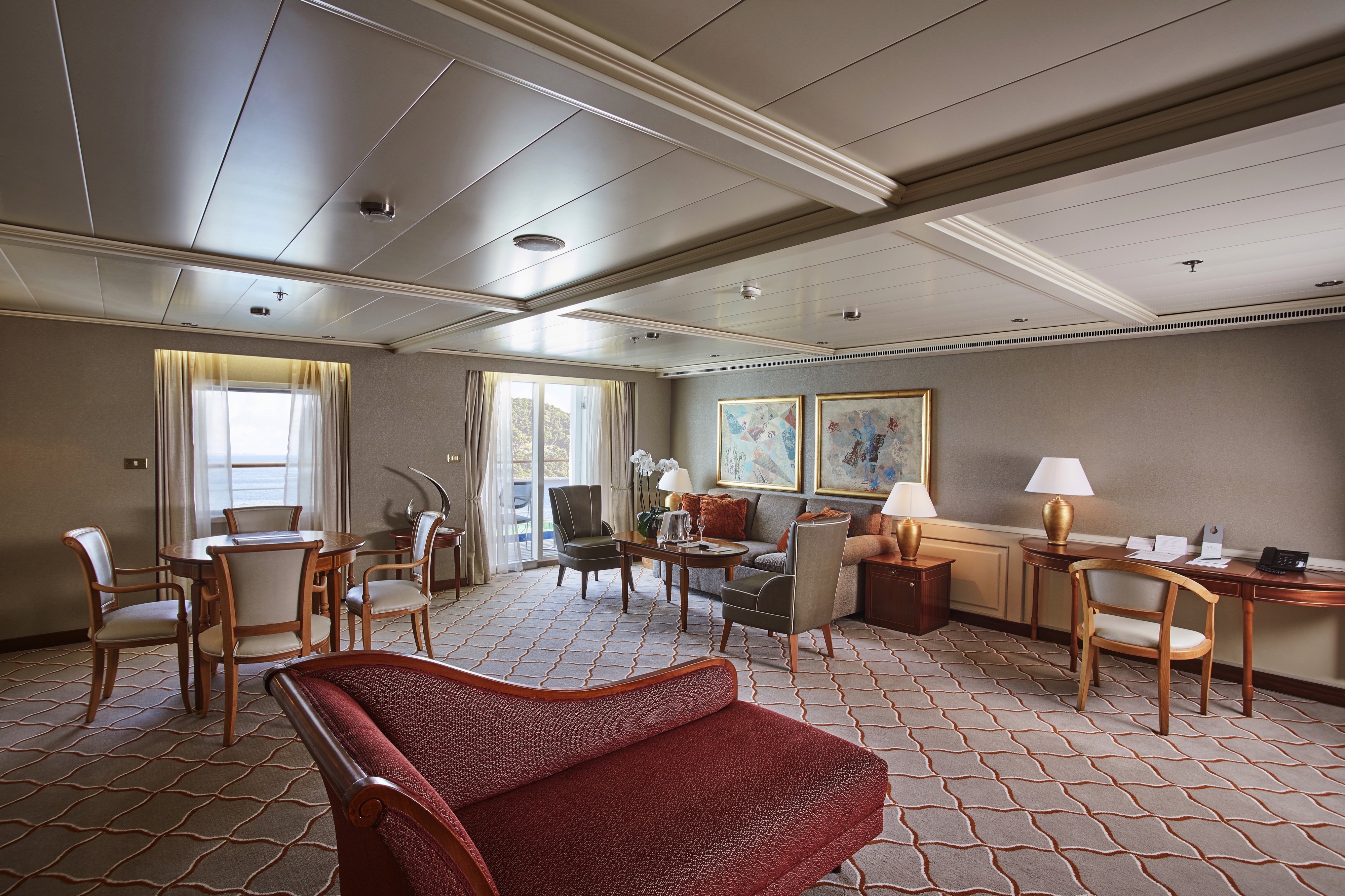
Grand Suite
Expertly designed and exquisitely appointed. Ideal for entertaining friends on your luxury cruise or enjoying a quiet dinner “at home”. Available as a one-bedroom suite configuration or as two-bedrooms (as illustrated) by adjoining with a Veranda Suite.
One bedroom: 87-101 sq.m. including veranda
Two bedroom: 119-133 sq.m. including veranda
Please note that the 3rd guest will sleep on a comfortable sofa bed in the reception area of the suite.
Essentials
- Deck(s): 6, 7, 8
- Section: Forward
Characteristics
- Veranda
- Separate dining area
- Living room with sitting area
- Double vanity
- Separate shower
- Full-size bath
- Walk-in wardrobe with personal safe
Furniture
- Queen size bed
- Writing desk
- Vanity table
- Luxury bed mattresses
Media & Communication
- Unlimited Premium Wi-Fi
- 2 large flat screen TVs with Interactive Media Library
- Sound system with bluetooth connectivity
- Direct dial telephone
- Wall mounted USB-C mobile device chargers
- Dual voltage 110/220 outlets
Onboard Services
- Butler service
- Complimentary laundry, pressing & wet cleaning
- Daily canapé service, Welcome chocolate, Welcome fruit stand
- Dinner for two in La Dame, one evening per voyage,
- Two hours of worldwide phone use, per voyage segment
- Champagne on arrival
Amenities
- Espresso machine
- Pillow menu
- Refrigerator and bar setup stocked with your preferences
- Plush bathrobe
- Luxury bath amenities
- Umbrella
- Hair Dryer
- Slippers
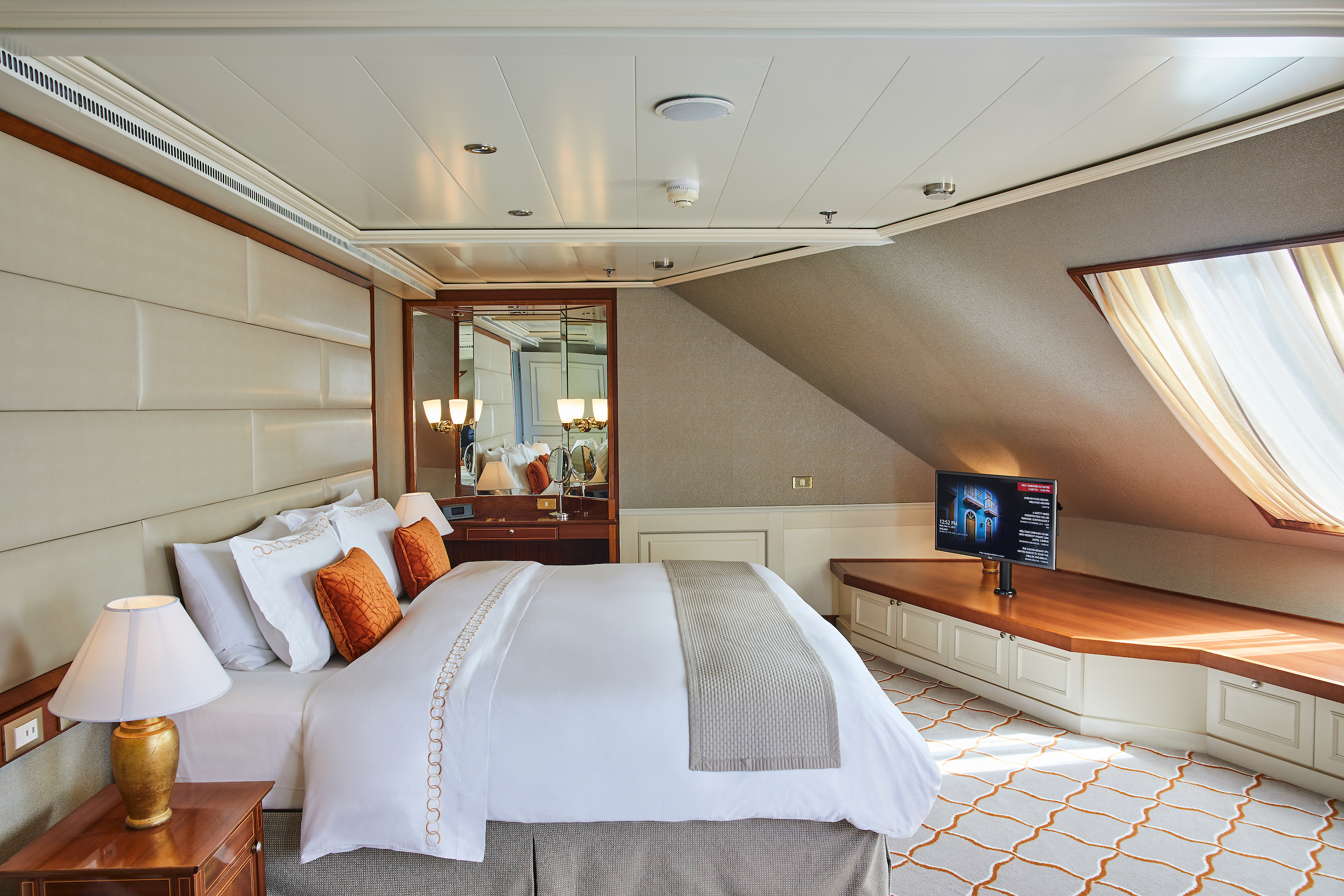
Royal Suite
Stately describes the Royal suite. Commanding and majestic. Perfect for entertaining while you cruise. Enough living space to roam.The pinnacle of good living. Available as a one-bedroom configuration or as two-bedrooms (as illustrated) by adjoining with a Veranda Suite.
One bedroom: 90–94 sq m including veranda (10–11 sq m)
Two bedrooms: 122–126 sq m including veranda (16–17 sq m)
Please note that the 3rd guest will sleep on a comfortable sofa bed in the reception area of the suite.
Essentials
- Deck(s): 6, 7
- Section: Forward
Characteristics
- Veranda
- Separate dining area
- Living room with sitting area
- Double vanity
- Separate shower
- Full-size bath
- Walk-in wardrobe with personal safe
Furniture
- Queen size bed
- Writing desk
- Vanity table
- Luxury bed mattresses
Media & Communication
- Unlimited Premium Wi-Fi
- 2 large flat screen TVs with Interactive Media Library
- Sound system with bluetooth connectivity
- Direct dial telephone
- Wall mounted USB-C mobile device chargers
- Dual voltage 110/220 outlets
Onboard Services
- Butler service
- Complimentary laundry, pressing & wet cleaning
- Daily canape service, Welcome chocolate, Welcome fruit stand
- Dinner for two in La Dame, one evening per voyage,
- Two hours of worldwide phone use, per voyage segment
- Champagne on arrival
Amenities
- Espresso machine
- Pillow menu
- Refrigerator and bar setup stocked with your preferences
- Plush bathrobe
- Luxury bath amenities
- Umbrella
- Hair Dryer
- Slippers

Silver Suites
Stylish and sophisticated. Separate dining and living rooms. Larger verandas. Situated midship. Perfection in design for comfortable living. Silver Suites accommodate three guests.
One bedroom: 61-65 sq.m. including veranda
Please note that the 3rd guest will sleep on a comfortable sofa bed in the reception area of the suite.
Essentials
- Deck(s): 7
- Section: Mid-Ship
Characteristics
- Veranda
- Separate dining area
- Sitting area
- Double vanity
- Separate shower
- Full-size bath
- Walk-in wardrobe with personal safe
Furniture
- Queen size bed
- Writing desk
- Vanity table
- Luxury bed mattresses
Media & Communication
- Unlimited Premium Wi-Fi
- 2 large flat screen TVs with Interactive Media Library
- Sound system with bluetooth connectivity
- Direct dial telephone
- Wall mounted USB-C mobile device chargers
- Dual voltage 110/220 outlets
Onboard Services
- Butler service
- Complimentary laundry, pressing & wet cleaning
- Daily canapé service, Welcome chocolate, Welcome fruit stand
- Champagne on arrival
Amenities
- Espresso machine
- Pillow menu
- Refrigerator and bar setup stocked with your preferences
- Plush bathrobe
- Luxury bath amenities
- Umbrella
- Hair Dryer
- Slippers
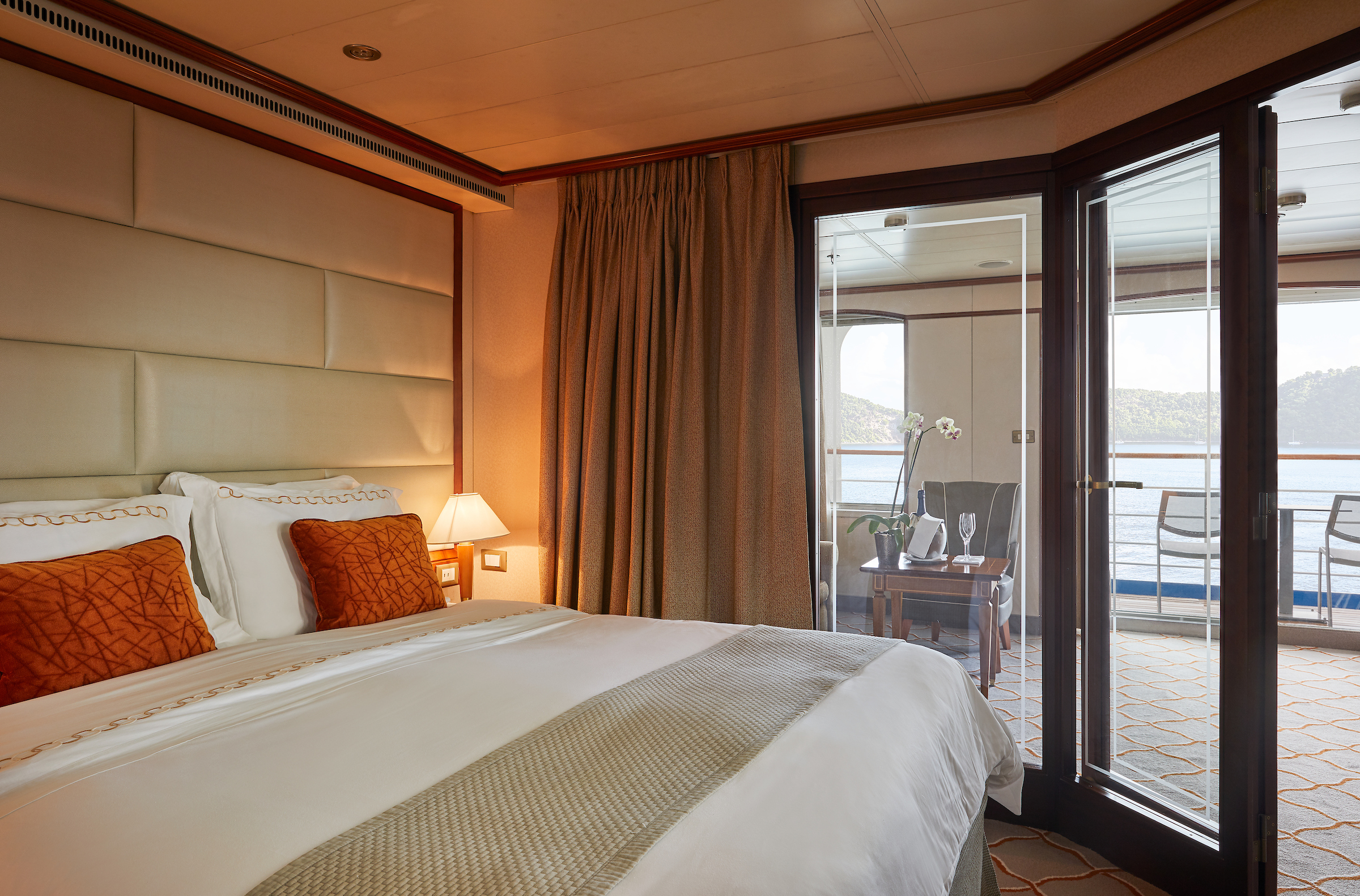
Medallion Suite
A mark of distinction. Sumptuous. Spacious. Rich textures and panoramic views surround you with distinguished luxury.
An extravagant suite for an extravagant cruise.
One bedroom: 49 sq.m. including veranda
Please note that the 3rd guest will sleep on a comfortable sofa bed in the reception area of the suite.
Essentials
- Deck(s): 7
- Section: Mid-Ship
Characteristics
- Veranda
- Sitting area
- Double vanity
- Separate shower
- Full-size bath
- Walk-in wardrobe with personal safe
Furniture
- Queen size bed
- Writing desk
- Vanity table
- Luxury bed mattresses
Media & Communication
- Unlimited Premium Wi-Fi
- 2 large flat screen TVs with Interactive Media Library
- Sound system with bluetooth connectivity
- Direct dial telephone
- Wall mounted USB-C mobile device chargers
- Dual voltage 110/220 outlets
Onboard Services
- Butler service
- Complimentary laundry, pressing & wet cleaning
- Daily canape service, Welcome chocolate, Welcome fruit stand
- Champagne on arrival
Amenities
- Espresso machine
- Pillow menu
- Refrigerator and bar setup stocked with your preferences
- Plush bathrobe
- Luxury bath amenities
- Umbrella
- Hair Dryer
- Slippers
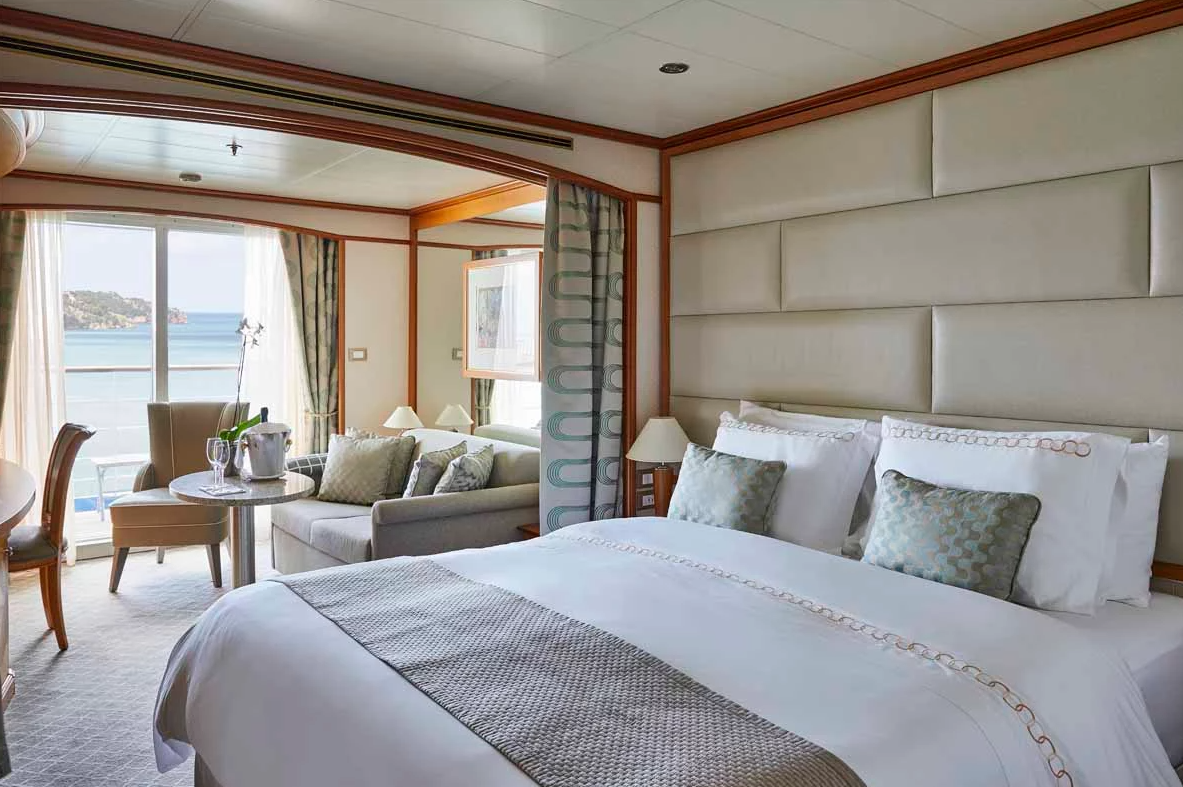
Deluxe Veranda Suite
Spacious and immaculate, the Deluxe Veranda is just perfect to for relaxing whether it’s morning, noon or night! A perfect mid-ship location, why not enjoy a pre-dinner drink, breakfast with a view or just enjoy the gentle evening breeze on your private teak veranda? From relaxing in the ultra-luxury marble bathroom to enjoying your best night’s sleep ever, the Deluxe Veranda is the savvy traveller’s choice.
One bedroom: 32 sq m including veranda (6 sq m)
Please note that the 3rd guest will sleep on a comfortable sofa bed in the reception area of the suite.
Essentials
- Deck(s): 6, 8, 9
- Section: Forward, Mid-Ship
Characteristics
- Veranda
- Sitting area
- Double vanity
- Separate shower
- Full-size bath
- Walk-in wardrobe with personal safe
Furniture
- Queen size bed
- Writing desk
- Vanity table
- Luxury bed mattresses
Media & Communication
- Unlimited Standard Wi-Fi
- 1 large flat screen TV with Interactive Media Library
- Direct dial telephone
- Wall mounted USB-C mobile device chargers
- Dual voltage 110/220 outlets
Onboard Services
- Butler service
- Champagne on arrival
- Amenities
- Pillow menu
- Refrigerator and bar setup stocked with your preferences
- Plush bathrobe
- Luxury bath amenities
- Umbrella
- Hair Dryer
- Slippers

Superior Veranda Suite
Superior by name and superior by nature! Where do we begin? From beautiful bed linens to sumptuous furniture, our Superior Veranda suites are luxury inside and out! Whether enjoying some down time with the state of the art entertainment system or taking in the most spectacular views from the comfort of your suite veranda, the Superior Veranda is the cosiest home away from home on the high seas.
One bedroom: 32 sq.m. including veranda
Wheelchair accessible suites: 535 and 537
Please note that the 3rd guest will sleep on a comfortable sofa bed in the reception area of the suite.
Essentials
- Deck(s): 5, 6, 7, 8
- Section: Forward, Mid-Ship
Characteristics
- Veranda
- Sitting area
- Double vanity
- Separate shower
- Full-size bath
- Walk-in wardrobe with personal safe
Furniture
- Queen size bed
- Writing desk
- Vanity table
- Luxury bed mattresses
Media & Communication
- Unlimited Standard Wi-Fi
- 1 large flat screen TV with Interactive Media Library
- Direct dial telephone
- Wall mounted USB-C mobile device chargers
- Dual voltage 110/220 outlets
Onboard Services
- Butler service
- Champagne on arrival
Amenities
- Pillow menu
- Refrigerator and bar setup stocked with your preferences
- Plush bathrobe
- Luxury bath amenities
- Umbrella
- Hair Dryer
- Slippers
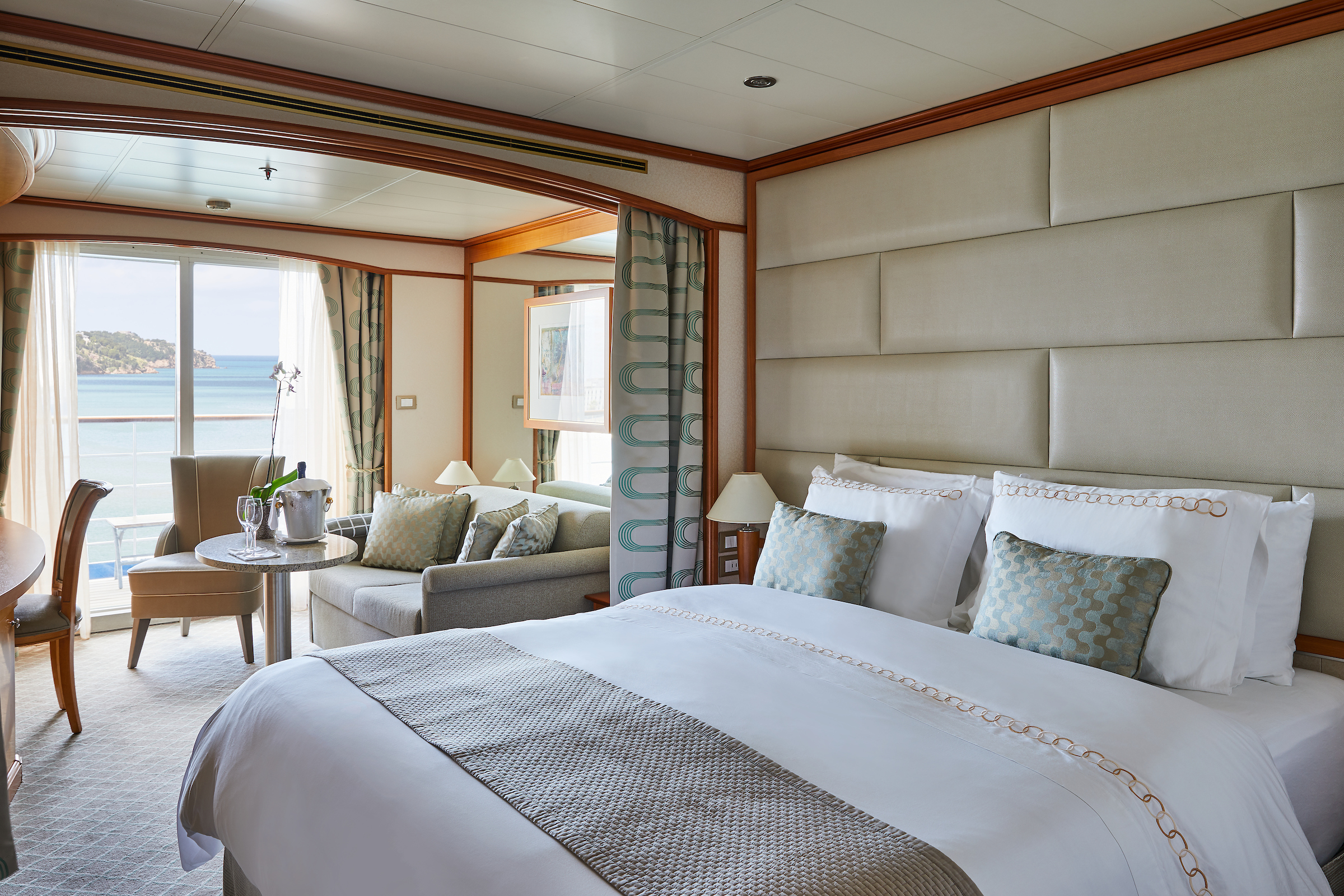
Classic Veranda Suite
After a busy day of exploring, welcome home to the haven of the Classic Veranda Suite. With butler service, a queen size bed (which can be separated on demand) and beautiful marble bathroom, you won’t want to leave! However, the best part of our Classic Veranda suite is by far the large, private, teak veranda for which the suite is named. Pure bliss.
One bedroom: 32 sq.m. including veranda
Please note that the 3rd guest will sleep on a comfortable sofa bed in the reception area of the suite.
Essentials
- Deck(s): 5, 6
- Section: Forward, Mid-Ship
Characteristics
- Veranda
- Sitting area
- Double vanity
- Separate shower
- Full-size bath
- Walk-in wardrobe with personal safe
Furniture
- Queen size bed
- Writing desk
- Vanity table
- Luxury bed mattresses
Media & Communication
- Unlimited Standard Wi-Fi
- 1 large flat screen TV with Interactive Media Library
- Direct dial telephone
- Wall mounted USB-C mobile device chargers
- Dual voltage 110/220 outlets
Onboard Services
- Butler service
- Champagne on arrival
Amenities
- Pillow menu
- Refrigerator and bar setup stocked with your preferences
- Plush bathrobe
- Luxury bath amenities
- Umbrella
- Hair Dryer
- Slippers
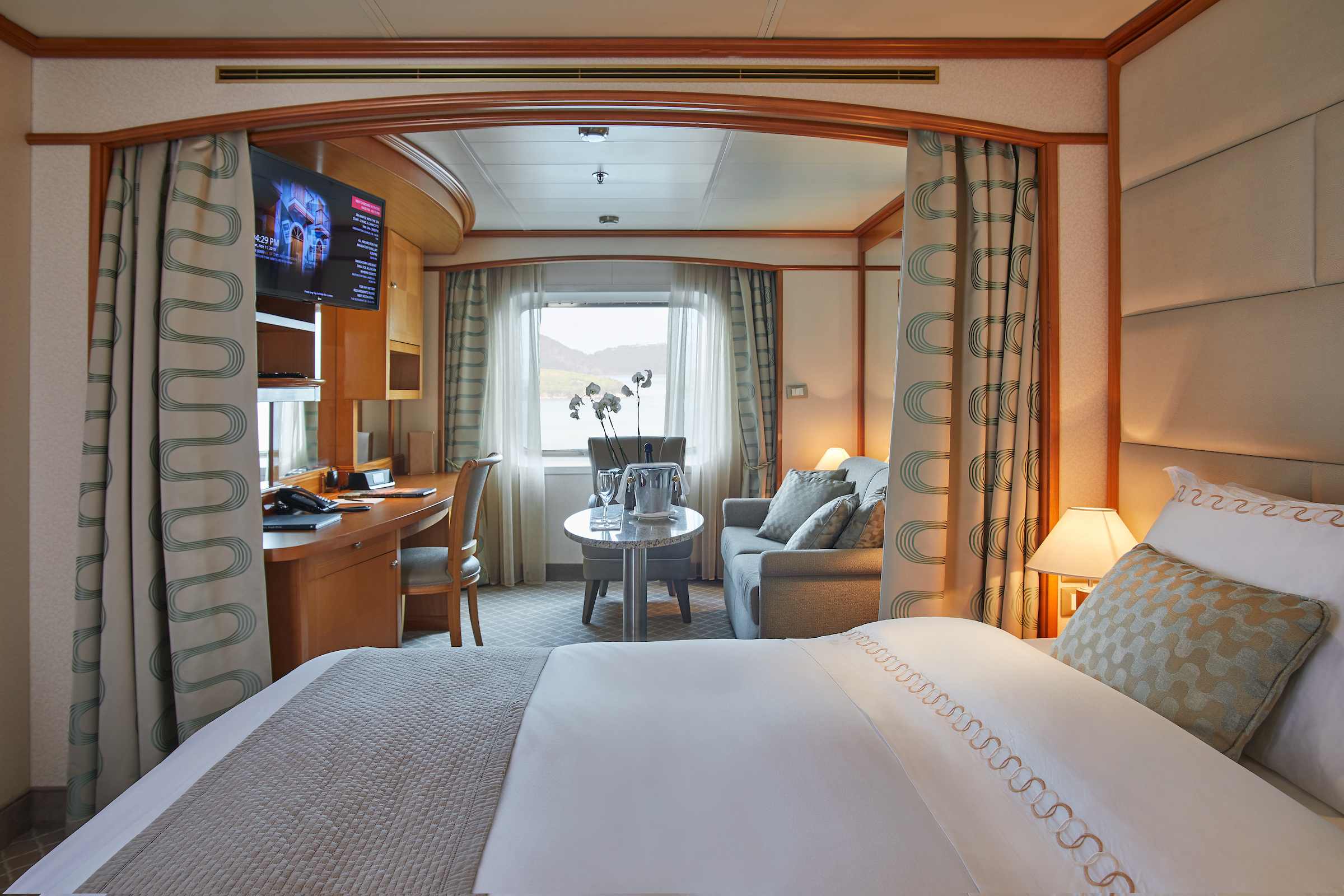
Vista Suite
A quiet sanctuary. The sitting area of the Vista suite has plenty of room to relax. Large picture windows frame panoramic ocean views. The perfect backdrop for breakfast in bed during the cruise.
One bedroom: 27 sq.m.
Essentials
- Deck(s): 4, 5
- Section: Forward
Characteristics
- Large Balcony Window
- Sitting area
- Double vanity
- Separate shower
- Full-size bath
- Walk-in wardrobe with personal safe
Furniture
- Queen size bed
- Writing desk
- Vanity table
- Luxury bed mattresses
Media & Communication
- Unlimited Standard Wi-Fi
- 1 large flat screen TV with Interactive Media Library
- Direct dial telephone
- Wall mounted USB-C mobile device chargers
- Dual voltage 110/220 outlets
Onboard Services
- Butler service
- Champagne on arrival
Amenities
- Pillow menu
- Refrigerator and bar setup stocked with your preferences
- Plush bathrobe
- Luxury bath amenities
- Umbrella
- Hair Dryer
- Slippers

La Terrazza
Authentic Italian recipes and the freshest, sustainable ingredients come together in this restaurant at sea.
On board this luxury cruise ship a divine selection of Italy’s best cuisine is served à la carte in La Terrazza. Authentic recipes and the freshest ingredients come together with flair and passion aboard this luxury cruise — a flavourful expression of Silversea’s distinctive Italian heritage. La Terrazza uses buffalo mozzarella from Naples, organic balsamic vinegar and olive oil from Umbria, and air-dried ham out of Parma. The Emilia-Romagna region also produces Silversea’s 24-month aged Parmigiano Reggiano, while the pasta is made daily right on board. La Terrazza is open for casual, buffet-style breakfast and lunch with indoor or al fresco dining on the outdoor terrace. During the evening, La Terrazza transforms into an à la carte traditional Italian restaurant.
Open-seating for breakfast and lunch.
Seating is limited for dinner and reservations are recommended.

The Grill
A Silversea staple, The Grill is where casual dining meets impeccable taste. Savour the best of land and sea, from marbled steaks to seared branzino in a relaxed atmosphere overlooking endless blue. Pair the perfect glass of wine with your dish, enhancing each bite with every sip. And for the ultimate finale, end with a decadent dessert.
Dress code: Casual
Casual wear consists of pants, blouses, or casual dresses for women; open-neck shirts and slacks for men are appropriate
Images are intended as a general reference. Features, materials, finishes and layout may be different than shown.
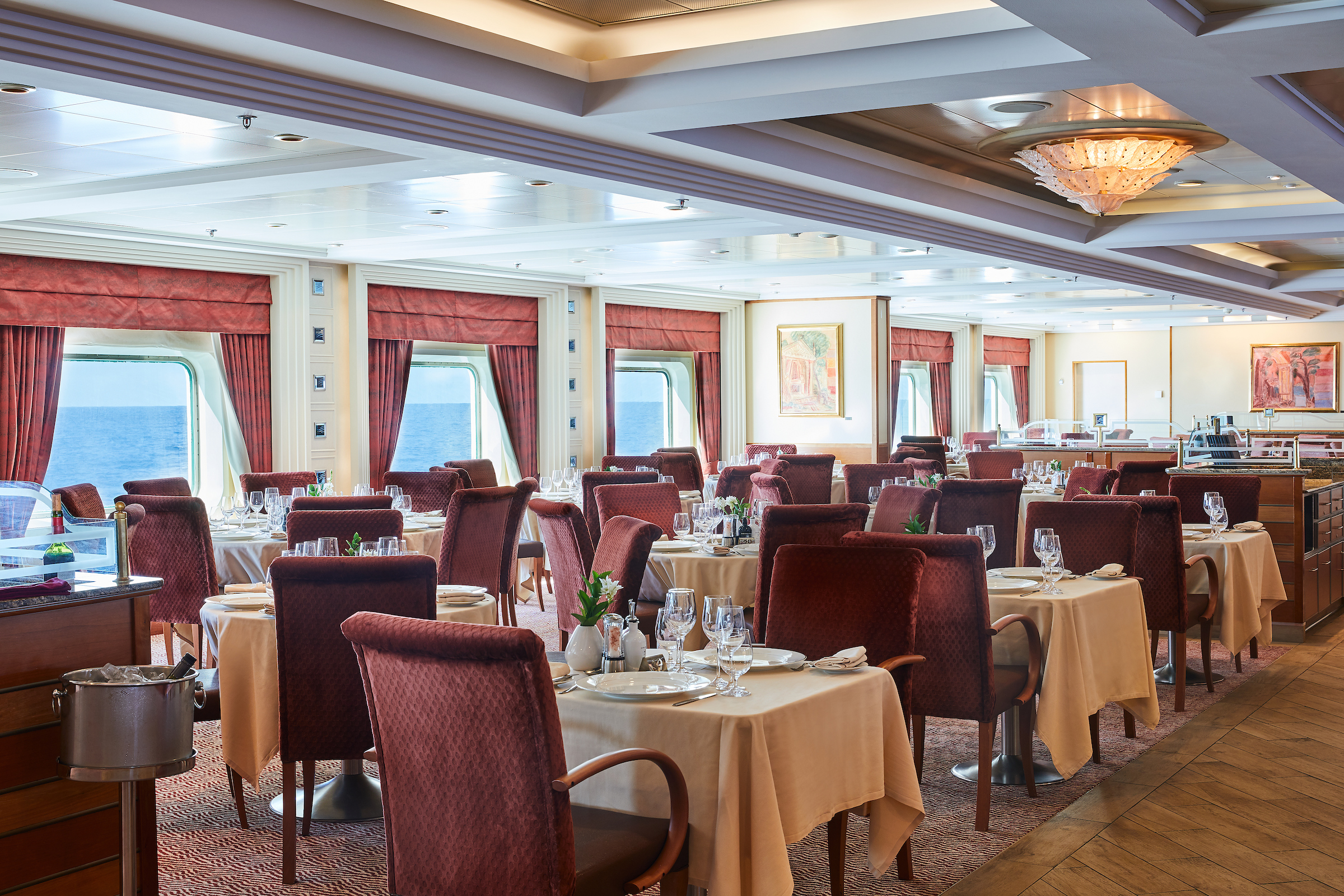
The Restaurant
Enjoy Continental and regional specialities, as well as sweeping ocean views in our main dining room.
Sparkling with silver, crystal and candlelight, this luxury cruise ship’s main dining room serves contemporary, international cuisine with sophisticated elegance and impeccable service. Menus feature regional specialities unique to the voyage destination, for example, Roasted Chilean Sea Bass while cruising the Chilean fjords and Indian Chicken Korma en route to Mumbai. The Restaurant on board this luxury cruise ship offers open-seating dining, which means there are no assigned times, no assigned tables. You are free to dine when, where and with whom you please.

La Dame
La Dame features a bespoke menu by our top chefs, and it is the highest expression of excellence in French dining. The ambience is one of chic, contemporary style, with crisp, white table linens and the impeccable white-gloved service associated with Silversea. Named after “La Dame de Paris,” or the Eiffel Tower, La Dame echoes the traditions and cultures embedded in the French gastronomic past while respecting its bright culinary future. Quintessentially Parisian, extremely elegant, and very refined, meals at La Dame are a fusion of tradition and modernity.
Per guest reservation fee of US$60. Please visit My Silversea to make your reservations.
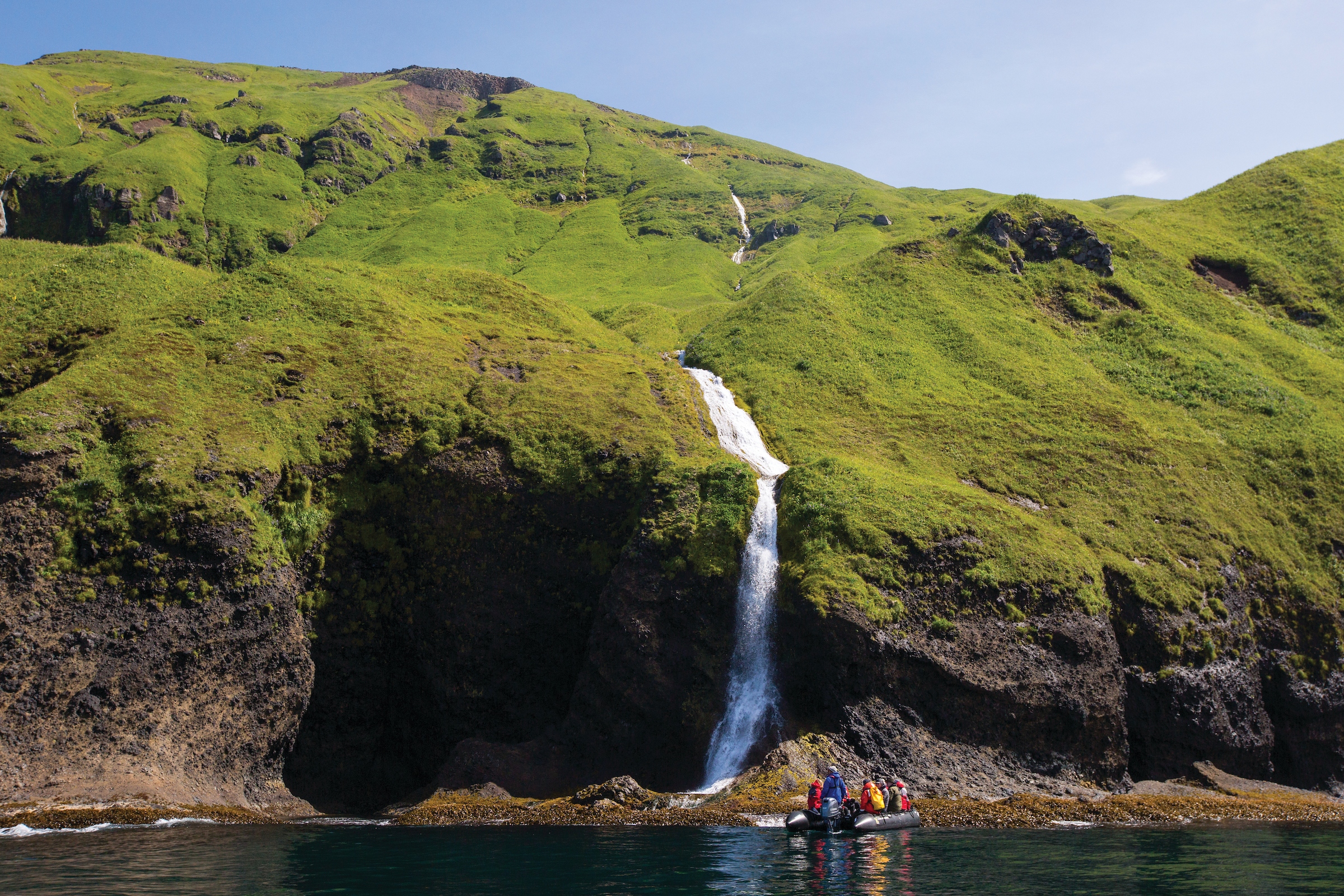
Shore Excursions
Silversea’s experienced Shore Concierge team are happy to assist, ensuring your shore- side experience is nothing less than a memory that lasts forever. Their knowledge and understanding of ports will truly add to your enjoyment and experience. Detailing history, local flavour, culture, regional customs, shopping tips and much more, they will make sure you get the best of your destination, wherever you are in the world.
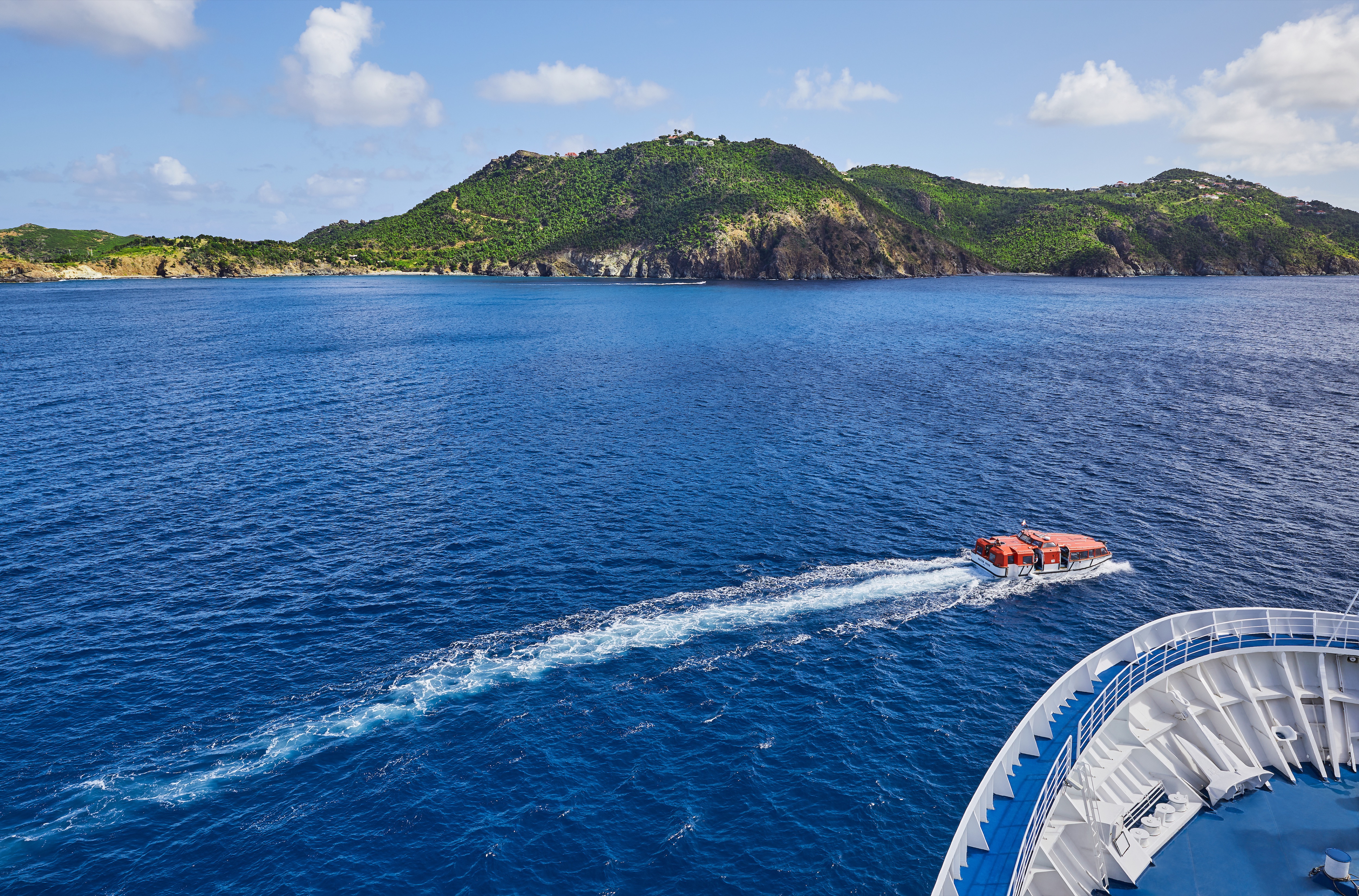
Mid-Voyage Adventures
Multiple days at sea mean plenty of R & R for some, but others prefer to drink in all there is to offer on land. Our Mid-Cruise Land Adventures allow you to take full advantage of your time with us without missing a single thing! These short escapades offer an array of adventures, break up your sea days and allow for deeper exploration beyond the coast.

Silver Shore Concierge
Let Silversea customise a special event or excursion exclusively for you. Expert Shore Excursion professionals are available to assist with all your shore questions. Make an appointment and gain insider access to knowledgeable suggestions, personalised planning and hassle-free coordination of all private, independent touring, including area highlights, flightseeing, water sports, and much more. Take advantage of this service either in advance of your voyage by email at shoreconcierge@silversea.com or on board by visiting the Silvershore® Concierge desk. Have the Silver Shore Concierge create your tailor-made tour, or be whisked away by private car for a day — the pace and agenda are up to you.

Panorama Lounge
Relax and unwind in the Panorama Lounge, a sophisticated yet amicable space offering beautiful ocean views as you enjoy your cruise.
The Panorama Lounge is specially designed by Silversea to provide an uninterrupted view of the day’s destination from the comfort of the luxury cruise ship’s interior. This is an ideal place to unwind, enjoy afternoon tea, listen to the pianist and watch the setting sun while you cruise. The drinks are complimentary, the music live and inviting. Enjoy dancing to a range of musical styles for every taste from standards to the latest club mixes.
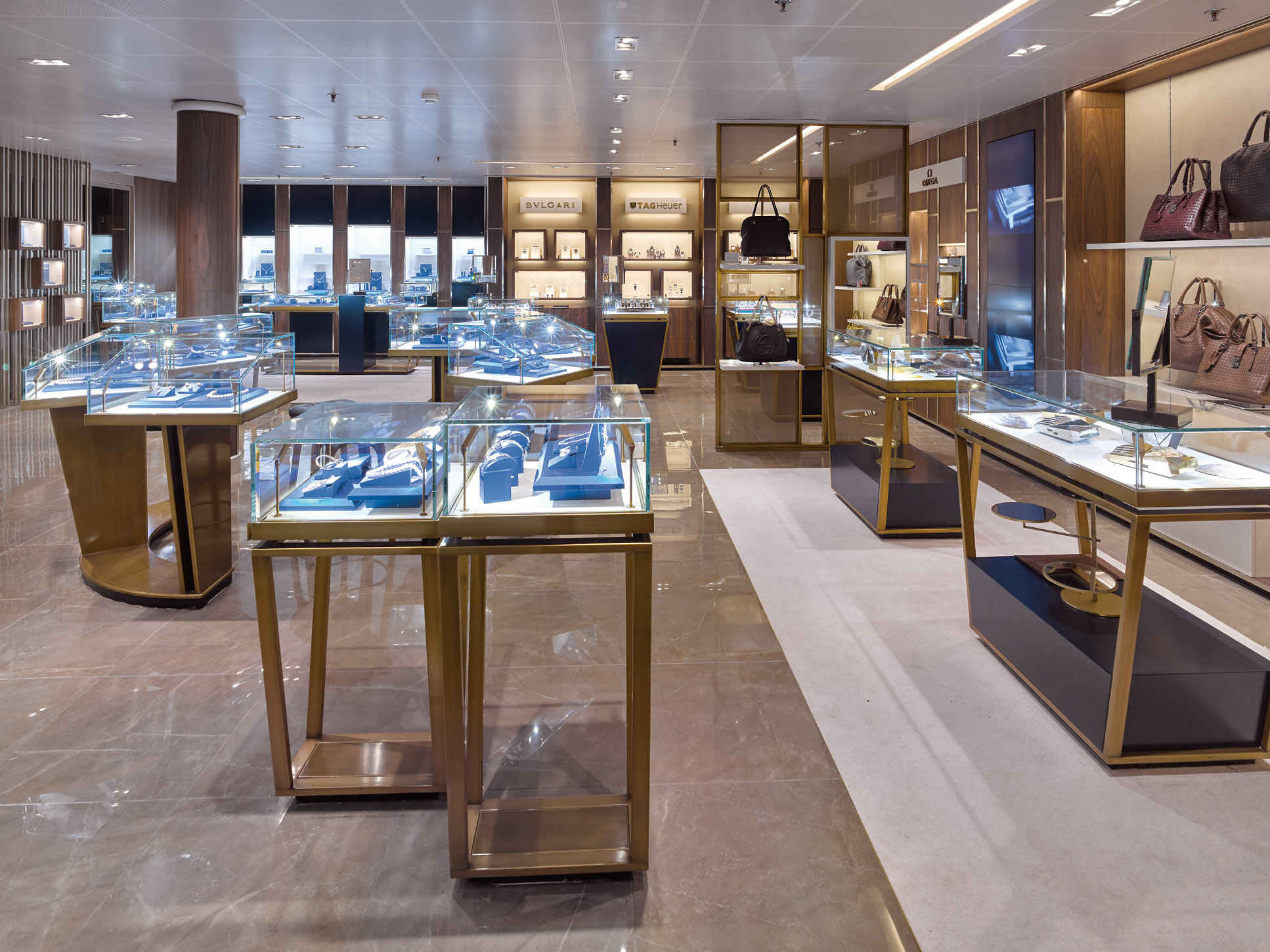
Boutique
There is a wealth of luxury shopping experiences aboard all Silversea ships, featuring the most distinctive and appealing brands from across the globe.
Exceptional shopping experiences do not end in the cosmopolitan cities we visit. Silversea’s striking new shipboard boutiques, reimagined and redesigned are stunning modern design spaces befitting the finest creations from legendary designers. Carefully selected partners onboard Silversea’s duty-free boutiques offers our guests a carefully curated selection of cutting edge fashions, jewellery, accessories, fine perfumes, cosmetics and Silversea Logo collection all at duty-free prices.
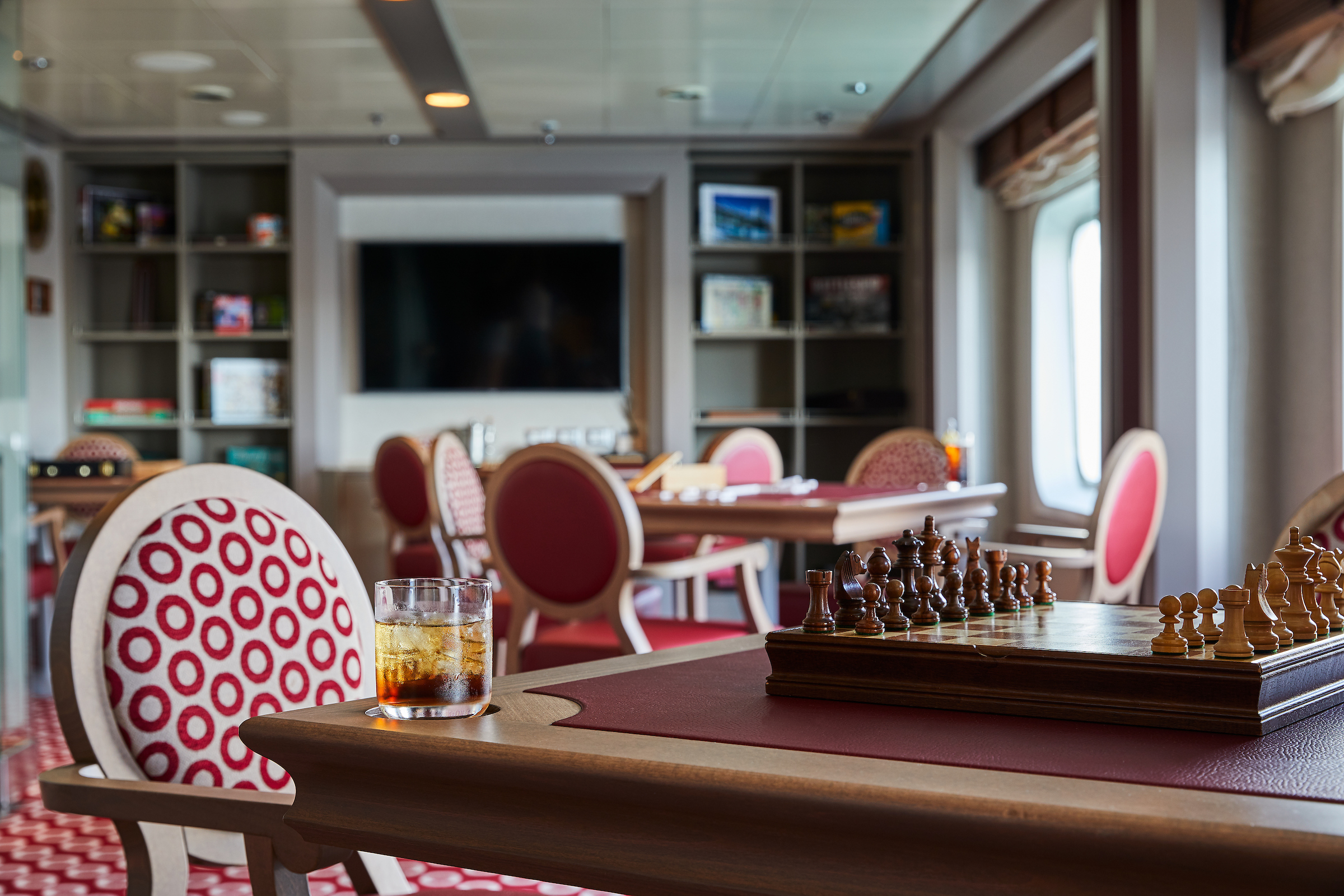
Conference / Card Room
Whether it is for a card tournament or conference, Silversea will provide a dedicated space for the perfect guest experience.
The Card Room on board this luxury cruise ship is where Bridge games and tournaments take place most days. On days at sea, newcomers to the game can learn how to play. Should your group require a conference or meeting space, Silversea is pleased to provide a tailor-made experience. Audio-visual equipment is available and complimentary on our top cruise line.
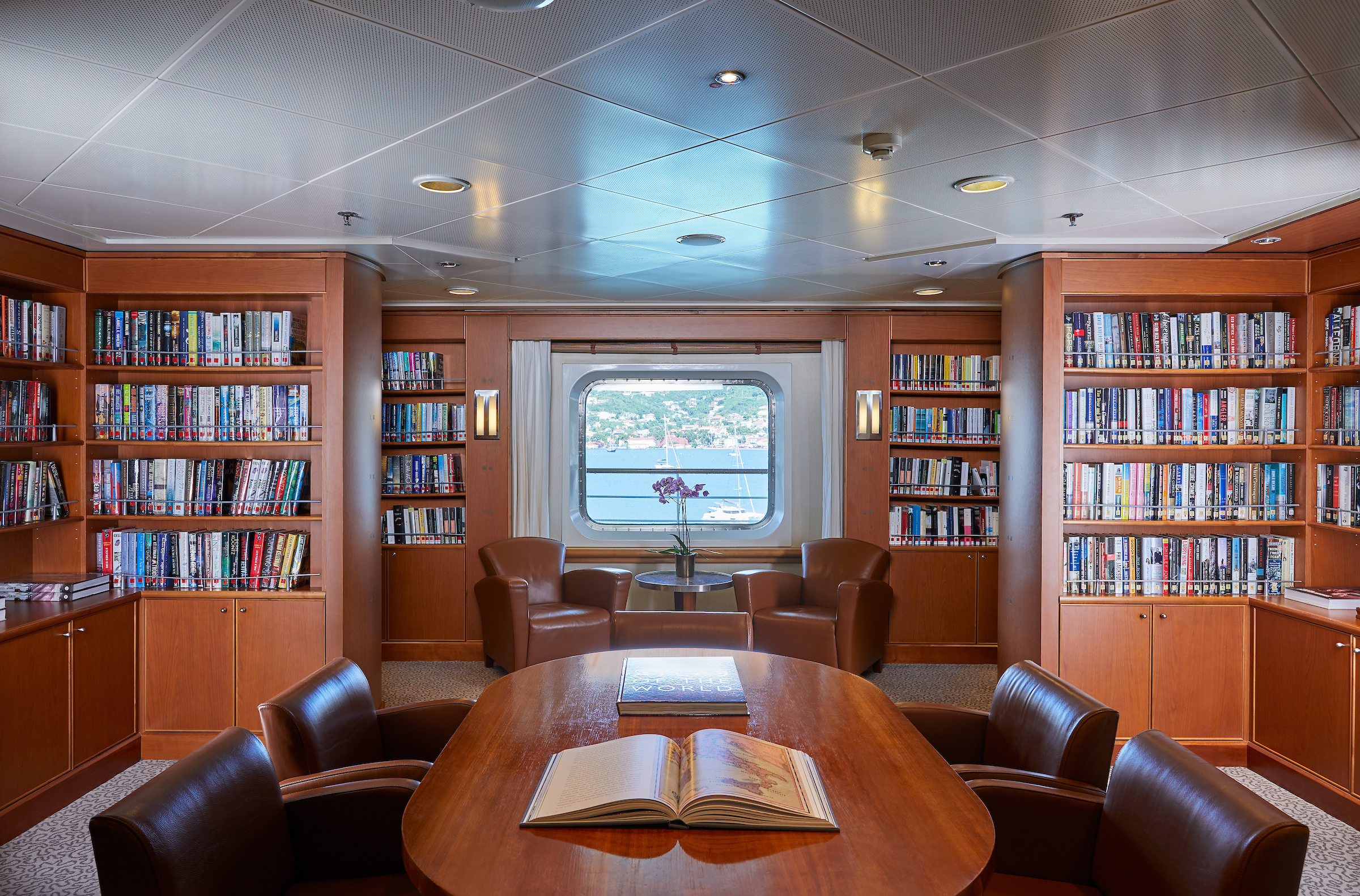
Library
Enjoy a selection of hardcover books, magazines, newspapers, and more during your luxury cruise.
The Library on board this luxury cruise ship has an extensive selection of hardcover books, magazines, reference materials and newspapers, as well as audio listening stations. Movies are also available and can be viewed on your in-suite entertainment centre while you cruise.
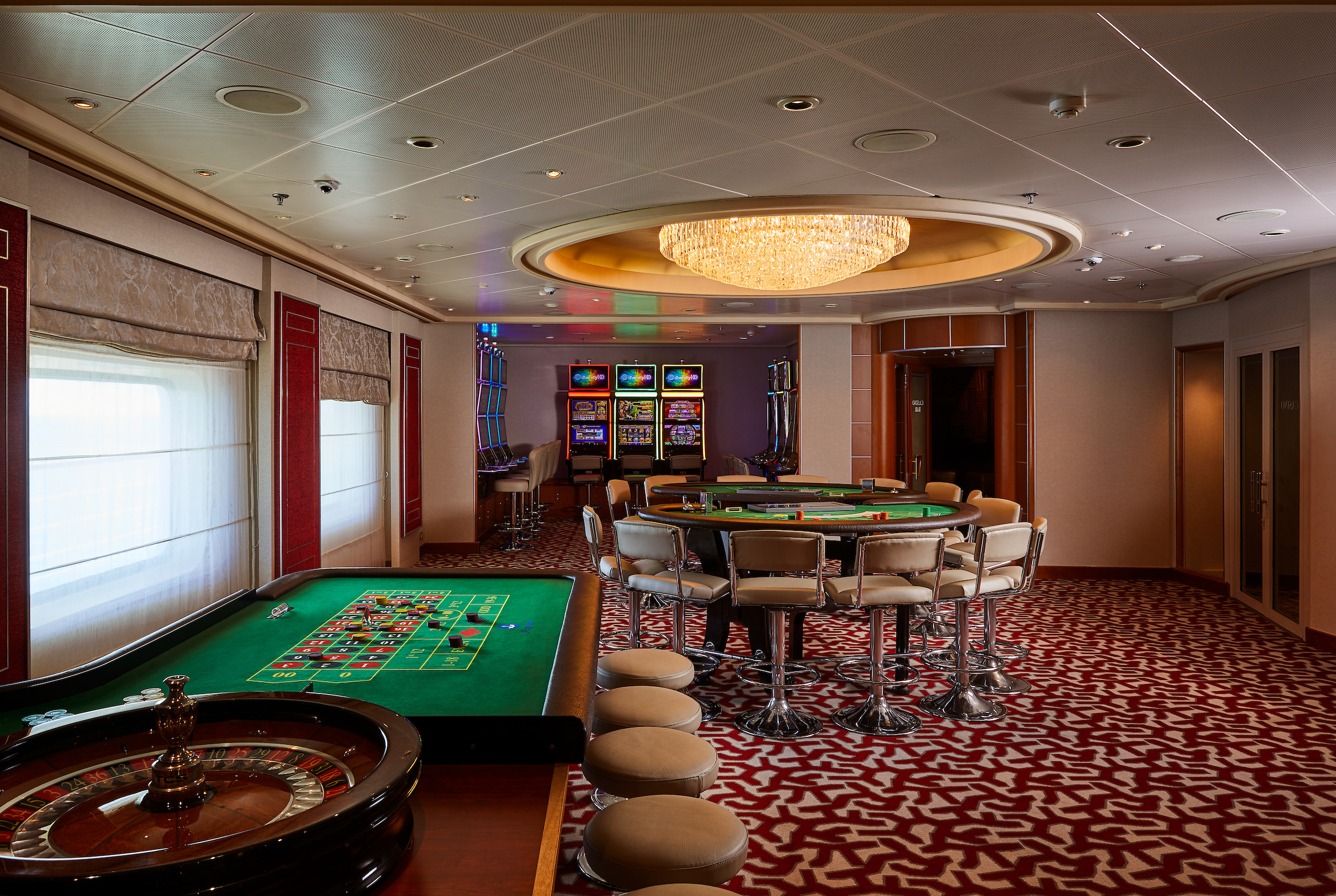
Casino
Enjoy a selection of games at the Silversea Casino for guests 18 and older, or discover new games during your luxury cruise.
Roulette, blackjack and slot machines are available while you cruise in The Casino for guests 18 years or older. If you are a novice, come to the champagne reception and learn all the games offered aboard this luxury cruise ship.

Reception
Be sure to visit the Reception area, where our experts can provide invaluable information to help you get the most out of your cruise.
This central lobby area of the Silver Whisper welcomes guests to speak with a Guest Relations specialist should they have a question or require any service. Assistance is available 24 hours a day on this luxury cruise ship. For guests wishing to make shoreside arrangements, the Silver Shore Concierge is available to assist with knowledgeable suggestions and personalised coordination of all private, independent touring, including sightseeing, water sports, golf, and more. The Cruise Consultant may prove indispensable when planning your next Silversea voyage, or if you wish to extend your current voyage for a day, a week, a month … Like having your own personal onboard Silversea professional, the Cruise Consultant will help you to select the perfect voyage, reserve your preferred suite, and provide immediate confirmation.

The Bar
No cruise is complete without meeting new people. Enjoy complimentary drinks and live music at the bar while meeting other guests.
With complimentary cocktails and engaging conversation, live music, and a dance floor, The Bar welcomes guests to mix and mingle while they cruise to their destination.

Observation Lounge
Set on the highest level at the very top of the ship, this is a quiet space for reading and reflection while being dazzled by the undulating seascapes that are constituent to life on board.
The eponymous lounge carries its name well. Set on the highest level at the very top of the ship, this is a quiet space for reading and reflection while being dazzled by the undulating seascapes that are essential to life on board. Borrow a book from the in-house library, read the papers, or just embrace the tranquility of being at sea.

Connoisseur's Corner
If you appreciate good cognac or premium cigars, be sure to visit the Connoisseur’s Corner to see the ship’s exceptional selection.
The Connoisseur’s Corner of this luxury cruise offers exceptional cognacs along with a premium selection of cigars for purchase.

Show Lounge
Enjoy a broad spectrum of entertainment-from full-scale production shows and classical soloists, to cultural entertainment and feature films.
Every seat in this luxury cruise ship’s multitiered venue enjoys a clear view of the stage. Enjoy a broad spectrum of entertainment brought to the Silver Whisper —from full-scale production shows and classical soloists, to cultural entertainment and feature films. Throughout your voyage, The Show Lounge also presents port talks, enrichment lectures, and a variety of special events throughout the cruise.
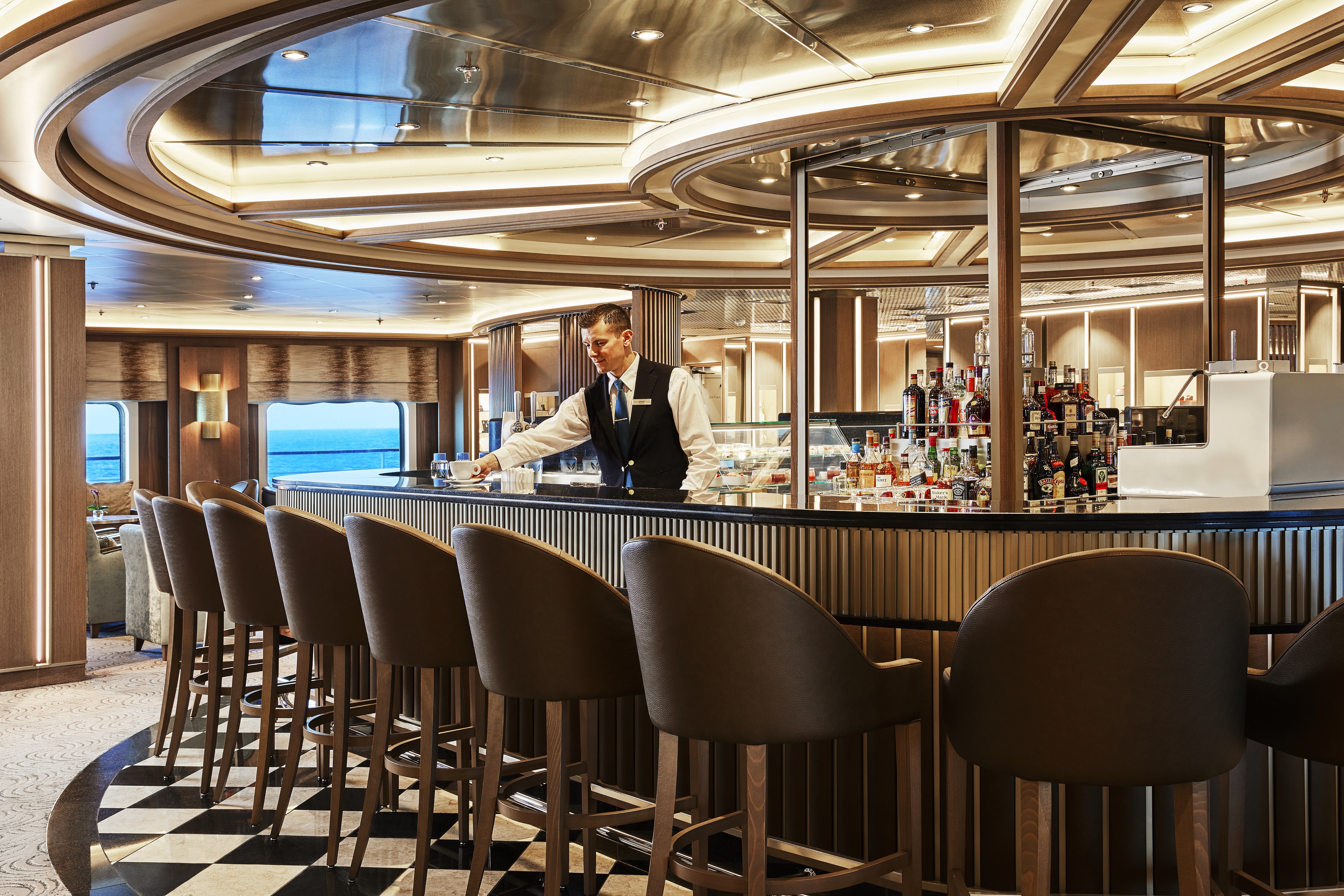
Atrium
The Atrium aboard provides a unique space at the heart of deck 5. Filled with natural light, this beautiful and spacious bar offers an all-day venue for drinks and snacks.
The Atrium aboard provides a unique space at the heart of deck 5. Filled with natural light, a beautiful and spacious bar blurs the line between traditional bar and modern brasserie, and offers an all-day venue for drinks and snacks in a relaxed, welcoming atmosphere. The elegant café serves light bites, as well as smoothies, fresh juices, bespoke cocktails, and wine by the glass from our extensive drinks menu, and it is the ideal place to meet your friends, grab a coffee or aperitif, and plan your next adventures.
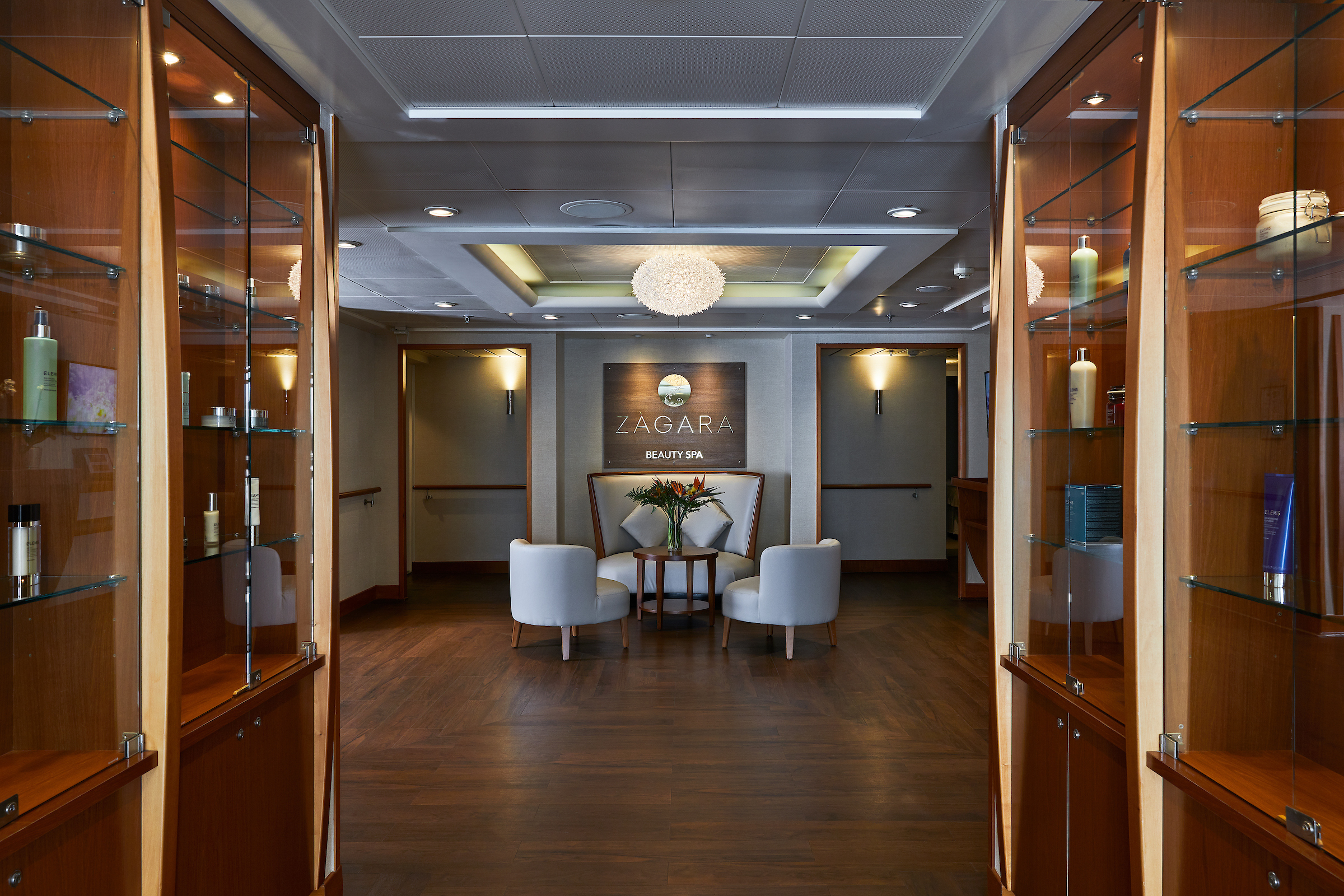
Zagara Beauty Spa
Come and indulge in a luxurious spa treatment. Facials, body wraps, massages: the spa is the perfect place to unwind.
Relax your body and mind in this luxury cruise ship’s soothing sanctuary. Indulge in a wide range of invigorating therapies at the spa, including facials, body wraps and massages. Appointments for these services may be made on board the ship, or in advance via My Silversea. Men’s and women’s saunas and steam rooms are perfect for relaxing before your luxury spa treatment or after your workout.

Fitness Centre
The Fitness Centre offers world-class equipment, classes, and personalised services.
The Fitness Centre on board this luxury cruise ship is equipped with free weights, weight machines, state-of-the-art treadmills, elliptical trainers and recumbent and upright bicycles. Classes in aerobics, yoga, Pilates and circuit training are led by the onboard fitness trainer and are always complimentary on Silversea’s best cruise line. Personal training, body composition analysis and specialty classes are available at an additional charge.
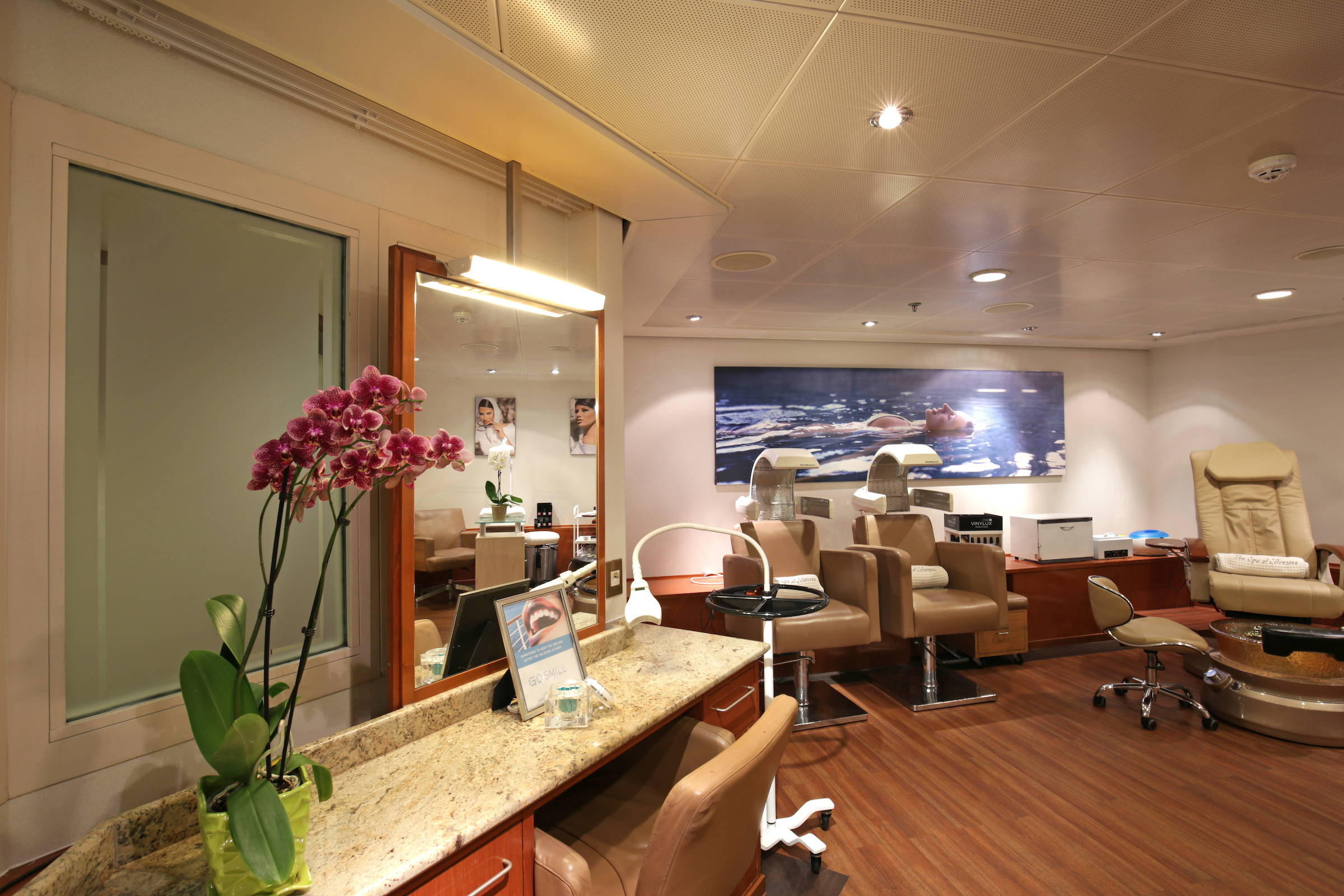
Zagara Beauty Salon
Maintain your fresh look throughout your luxury cruise at the Zagara Beauty Salon. Services are available for men and women.
A full range of salon services including hairstyling, manicures and pedicures, is available on board this luxury cruise ship for both men and women. Appointments for these chargeable services may be made on board the ship, or in advance via My Silversea. Maintain the look of prestige travel while you cruise.
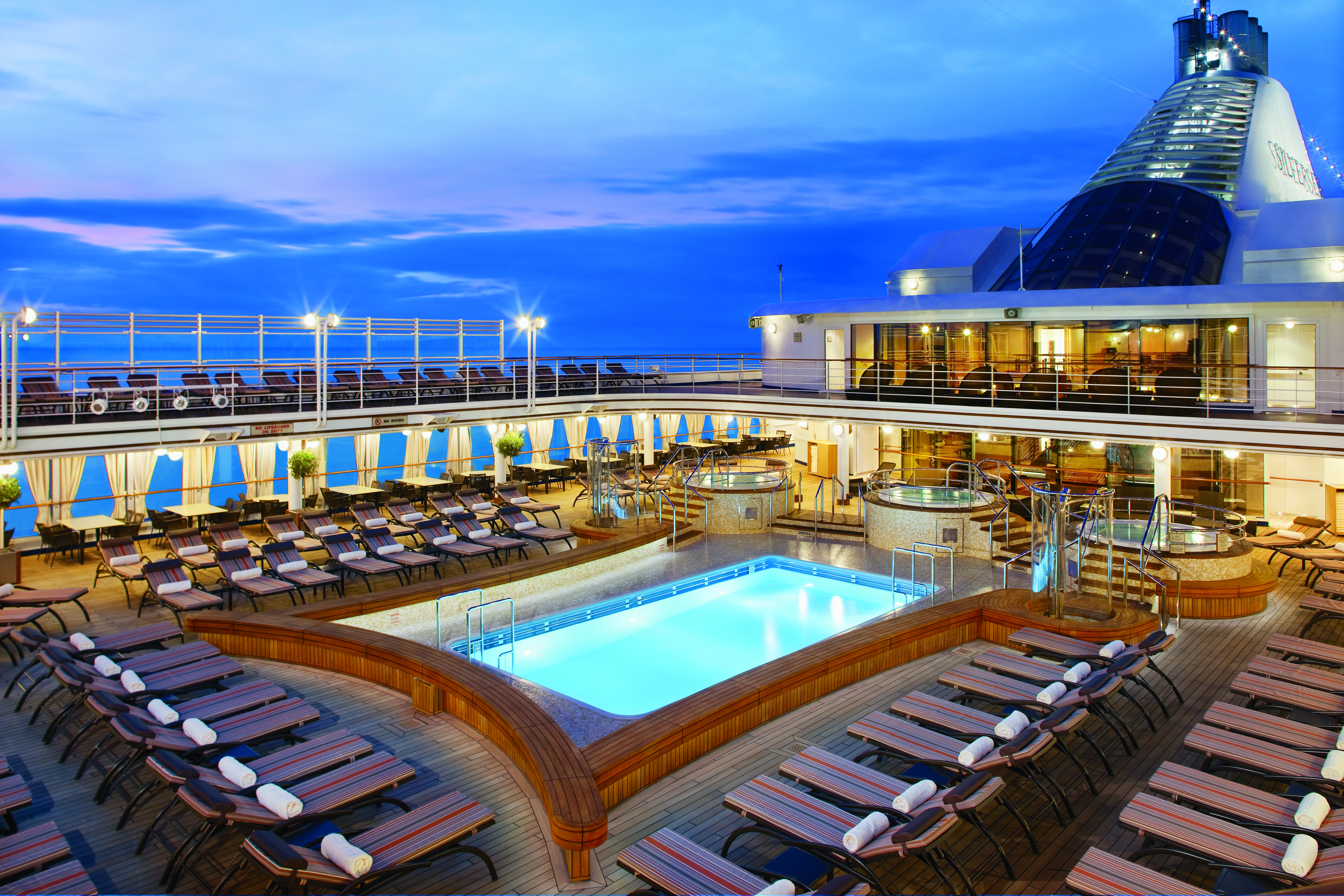
Pool Deck
Chaise lounges arranged in the sun or shade. Bubbling whirlpools. The pool water is refreshing in warmer climates and heated for cooler weather
Chaise lounges arranged in the sun or shade. Bubbling whirlpools. The pool water is refreshing in warmer climates and heated for cooler weather. Attentive staff is at the ready with an oversize towel as you emerge from the pool, with your favourite beverage at just the right moment. The luxury cruise ship of your dreams.

Jogging Track
A jogging track is available for guests, running the entire outside edge of the deck.
Dress Code
We have created this guide to help answer any questions you might have before you embark on your voyage. You may be wondering what you should pack in your suitcase and what kind of clothing to wear while on board and ashore. Perhaps you are unsure of what type of dress code is expected in our restaurants on board and what to wear while exploring ashore. We have provided answers here while anticipating your questions and concerns about what to wear and we hope you find it helpful. If we have not covered a specific query or concern, simply contact your travel professional or our Reservations Department.
We look forward to welcoming you on board. Bon voyage!
ON BOARD
We have a dress code on board, so we have created this overview to help you prepare.
OCEAN-GOING
Silversea has an onboard dress code after 6:00 p.m.
During the day, casual wear, similar to five-star resort sportswear, is suitable for daytime activities. It is recommended to wear flat or low-heeled shoes for deck activities.
Evening wear falls into two categories:
- Elegant Casual: On casual evenings, ladies may opt for trousers, a blouse, a skirt or a casual dress, while gentlemen may wear an open-collar shirt and dress pants. A jacket is optional.
- Formal Optional: A more formal attire may be chosen, such as an evening gown or cocktail dress for ladies and a tuxedo, dinner jacket, or dark suit with a tie for gentlemen. Alternatively, adhering to an Elegant Casual dress code is welcomed, but a jacket is still required for gentlemen in all indoor spaces.
Regardless of the daily dress code:
- After 6:00 pm, indoor spaces prohibit jeans, shorts, hats, caps, sneakers or flip-flop type footwear.
- Casual wear is always suitable in outdoor venues.
- Gentlemen dining at La Dame restaurants are required to wear a jacket.
The number of formal evenings depends on the length of the voyage. A guideline for reference is below:
- On sailings of 7 days or less, Elegant Casual nights throughout.
- On sailings of 8–14 days, expect between one to two Formal Optional nights.
- On sailings of 15 days or more, expect two or more Formal Optional nights.
EXPEDITION
Onboard Silver Endeavour, Silver Cloud and Silver Wind
Silversea has an onboard dress code after 6:00 p.m.
During the day, casual wear, similar to five-star resort sportswear, is suitable for daytime activities. It is recommended to wear flat or low-heeled shoes for deck activities.
Evening wear falls into the following category:
- Elegant Casual: On casual evenings, ladies may opt for trousers, a blouse, a skirt or a casual dress, while gentlemen may wear an open-collar shirt and dress pants. A jacket is optional.
Regardless of the daily dress code:
- After 6:00 pm, indoor spaces prohibit jeans, shorts, hats, caps, sneakers or flip-flop type footwear.
- Casual wear is always suitable in outdoor venues.
- Gentlemen dining at La Dame restaurants are are not required to wear a jacket. The use of a jacket is optional.
On board Silver Origin
On board Silver Origin, shipboard attire is always casual.
During the day, casual wear, similar to five-star resort sportswear, is suitable for daytime activities. Shoes should be non-skid, flat or low-heeled for deck activities.
Evening attire is casual; open-neck shirts, trousers and sports outfits are appropriate, with the exception of jeans and shorts, which are not permitted in The Restaurant.
ASHORE
As you’ll be traveling to some of the most remote environments on board our expedition ships, our Expedition Experts curated a packing list for each destination to help you prepare the right gear and clothing items that are essential for your upcoming adventure.
For additional expedition gear please visit Ship to Shore Traveller
How many formal nights are on my cruise, and what type of clothing is worn?
Find out what to pack. All the details are shown in the General Information section. For Silversea Expeditions guests, casual resort wear is appropriate at all times when on board, with the exception of two evenings when formal attire is required. For men, this means a jacket, tie optional.
Does Silversea offer tuxedo rental service?
No, however, the onboard boutique has a limited selection of formal wear attire for purchase.
Smoking Policy
At Silversea, the comfort, enjoyment and safety of all guests is paramount. To ensure a pleasant and safe environment, smoking is prohibited in most public areas, guest suites or suite balconies. However, cigarette, e-cigarette, cigar, pipe and vaporiser smoking is permitted in the Connoisseur’s Corner both indoors and outdoors (where applicable). In addition, cigarette, e-cigarette and vaporiser smoking is permitted in specifically designated outside areas and tables:
- Silver Nova, Silver Ray: Dusk Bar (port side);
- Silver Muse, Silver Spirit: Panorama Lounge (port side) and Pool Grill (port side);
- Silver Moon, Silver Dawn: Panorama Lounge (starboard side) and Pool Grill (port side);
- Silver Shadow, Silver Whisper: Panorama Lounge (starboard side) and Pool Grill (starboard side);
- Silver Cloud, Silver Wind: Panorama Lounge (port side) and Pool Grill (port side);
- Silver Origin: on open deck 4 aft;
Silversea kindly requests that all guests observe the non-smoking areas.
Disabled Facilities
Wheelchair guests must bring their own collapsible wheelchair. Please note that not all shore excursions are suitable for guests with impaired mobility. Silversea strongly recommends wheelchair guests travel with someone who is able to assist them both ashore and at sea as Silversea may be unable to offer special assistance. Please note that wheel-on and/or wheel-off access may not be available at some ports-of-call. Silversea reserves the right to deny boarding to any guest who failed to notify Silversea of such requirement at the time of booking.
Silversea welcomes guests with mobility needs and offers various accessibility features onboard. However, due to the nature of cruising, some destinations and excursions may present challenges. Below is a guide to help guests plan their journey.
BEFORE BOOKING
Do guests need to notify Silversea in advance about mobility needs?
Yes, guests should inform Silversea of any special assistance or mobility equipment requirements before sailing. This can be done via My Silversea under Guest Information / Special Request, or by contacting specialservices@silversea.com.
Does Silversea provide wheelchairs?
Yes, each vessel has wheelchairs available at the reception for temporary use, such as embarkation and disembarkation. Guests who require a wheelchair for the entire cruise should bring their own.
Can guests bring their own mobility equipment?
Yes, personal wheelchairs, scooters, and other mobility aids are allowed. However, guests staying in standard (non-ADA) suites should note that electric scooters may not fit through the doors.
Therefore, guests traveling with a wheelchair, scooter, or ECV are always highly suggested to book a wheelchair-accessible suite with a wider entrance door and an appropriate path of travel inside the room and accommodate the equipment. Regular Suites have a narrower entrance door and may not have the necessary interior space to accommodate wheelchairs and scooters.
What features do wheelchair-accessible suites offer?
Silversea ships offer specially designed suites for guests who require mobility assistance. These suites are equipped with wider entrance doors and appropriate paths of travel to accommodate wheelchairs, scooters, and other mobility equipment. All areas within these suites are reachable without the need for additional ramps, except for Silver Suites onboard Silver Moon and Silver Dawn and Classic Veranda onboard Silver Endeavour. In these suites Silversea offer ramp to go outside the balcony. The vessels also have wheelchairs available at the reception for guest use.
Where to find the information regarding the disabled access suites?
This information is visible under the Suite tab by suite category.
Also, can be found on the deck plan after clicking on the “View Deck Plan” tab on the ship page. The disabled access suites are indicated with the universal accessibility icon.
EMBARKATION & DISEMBARKATION
How do guests get on and off the ship with mobility equipment?
Silversea vessels have procedures in place to assist guests with mobility equipment during embarkation and disembarkation. When the gangway is flat, guests can drive their wheelchair off the ship. However, if the gangway involves stairs, our staff will provide assistance. The Safety Officer or Bridge must be informed whenever a wheelchair is involved in disembarkation or boarding, and our crew members are available to assist guests in need.
Is assistance available for boarding?
Yes, but guests who require full-time assistance should travel with a companion, as Silversea does not provide dedicated personal caregivers. Butlers can assist with getting to the gangway or dining venues but do not provide continuous mobility assistance.
ONBOARD
Silversea’s ships are designed for accessibility, featuring:
- Wide gangways to accommodate most wheelchairs and scooters
- Accessible public restrooms
- Wheelchair seating in dining venues, bars, and the Venetian Lounge
- Braille/tactile signage for visually impaired guests in elevators, stateroom numbers, and staircases
How does Silversea assist disabled guests in their suites?
Silversea butler can provide reasonable assistance to guest getting to and from the gangway, and to and from a restaurant, however Silversea does not offer full-time wheelchair service and/or staff fully dedicated to providing Guests with wheelchair assistance. Guests traveling on their own wheelchair should be assisted only when requested and are recommended to travel with an able bodily companion.
GOING ASHORE
Are all ports wheelchair accessible?
Not all ports have wheelchair-friendly infrastructure. In some destinations, tender boats or on Silversea Expeditions Zodiacs are required for disembarkation, and wheelchairs or mobility scooters cannot be accommodated in these cases.
Can guests arrange private accessible transportation in port?
If available, private wheelchair-accessible vehicles can be arranged. In some ports, shuttle buses may be wheelchair accessible, but availability is not guaranteed.
Does Silversea offer wheelchair-accessible shore excursions?
Until now we have been offering dedicated “Wheelchair Accessible Excursions” in some areas of the world., These tours are operated by wheelchair accessible vehicles and include only wheelchair accessible venues. These tours are mainly offered in Europe and the US. If you have any questions or concerns regarding shore excursion suitability, please contact the Shore Concierge (shoreconcierge@silversea.com) before your voyage or visit the Shore Concierge desk for more detailed information once onboard.
Wheelchair accessible shore excursions are indicated on the website with the universal accessibility icon.
Are there alternatives for guests with limited mobility?
In almost every port, Silversea offers low-activity excursions specially designed for mobility challenged guests, who can negotiate the steps on and off the coaches.
Is there any destination that is not recommend to guests with disabilities?
The more exotic destinations, like Asia, South Africa and South America it is recommended to guest to book a private vehicle due to the lack of infrastructure, for example wheelchair accessible vehicles are very rare to find and museums, restaurants and popular attractions are not often completely accessible.
Does Silversea offer wheelchair-accessible transportation between the ship and visiting site?
If available in the port yes, however this is not often available.
How Silversea assist disabled guests during excursions?
If wheelchair accessible excursions are not available, it is recommended to guests to book a private vehicle where they can have a dedicated guide and driver who can give them full attention. On regular shore excursions, the guide must look after all guests and may not be able to fully assist disabled guests.
Special Dietary Requirements
If you have special dietary requirements, Silversea will make every attempt to accommodate your requests. Please advise Silversea of your needs on the Guest Information Form at least 75 days prior to sailing. Notification should be sent to specialservices@silversea.com.
Medical Centre
Each Silversea ship is equipped with a Medical Centre, which is staffed by a doctor and nurse on 24-hour call when at sea. When docked, supplementary emergency care may also be obtained through local medical facilities. Guests may be charged for medical services and for medications used for their medical treatment. The Medical Centre is not intended or designed to provide on-going treatment of pre-existing conditions or for extended critical care, and Silversea is not responsible for the diagnosis, treatment or services furnished by shipboard medical personnel.
All guests are required to report in writing to Silversea at the time their reservation is made:
- Any physical or mental condition that may require medical or professional treatment or attention during the voyage
- Any condition that may render the guest unfit for travel, or that may require special care or assistance
- Any condition that may pose a risk or danger to the guest or anyone else on board the ship
- Any condition that may require oxygen for medical reasons
- Any intention or need to use a wheelchair aboard ship.
Age Restrictions
Applicable to all ships: Minors under the age of 18 must be accompanied, in the same or connecting suite, by a parent or other responsible adult over the age of 21 for the duration of the voyage and on all shore excursions and land programs. If the adult accompanying the minor is not their parent, a parental consent guardianship form must be signed by a parent or legal guardian and received by Silversea prior to sailing. Please contact our Special Services department at SpecialServices@Silversea.com for a Parental Consent Form. Silversea cannot accommodate infants under six months of age and reserves the right to limit the number of children under three years of age. Guests must be 21 years of age or older to consume alcohol. Silversea reserves the right to refuse to serve anyone who in its sole judgment may be under the influence of alcohol, or for any reason necessary to preserve the health and safety of guests and employees. Children under the age of eight years old are only permitted to participate in suitable Silver Shore Excursions / shuttle service if the vehicles are equipped with the correct safety harness and seating equipment. Child harnesses and secure seating cannot be guaranteed. Silversea reserves the right to refuse children under the age of eight years old on any tour on the basis of safety. Guests may use their own approved safety seat, booster seat or harness provided they are compatible with the local touring vehicle and can properly secure the child.
Laundry Service
Complete valet services, including laundry, pressing and wet cleaning, are available at an additional charge and may be arranged through your butler. Laundry service is complimentary on higher category suites (Premium Medallion, Medallion, Silver, Royal, Grand, Junior Grand, Signature, Master, Otium and Owner’s Suites) and for those Venetian Society members who have reached certain reward levels. click here to learn more. A self-service laundromat offers washing machines, dryers, irons and laundry supplies, allowing you to limit the amount of cruise luggage needed, especially for longer voyages.
Wi-FI & Internet
All Silversea ships are equipped to offer wireless (Wi-Fi) Internet access. You can use your own laptop to surf the Internet and check emails at Wi-Fi locations throughout the ship, or from the comfort and privacy of your suite. Computers, email and Internet access are also available on board at the Internet Café. However, it is important to understand that telecommunication services while at sea are via satellite and significantly different than high-speed connections on land back home. The signal travels in a similar manner to radio waves but at much greater distances. Therefore, onboard Internet access is not guaranteed at all times. Satellite communications are also affected by weather and the ship’s location. In particular, Internet service is extremely sporadic while in the Arctic. Guests aboard expedition cruises to/from Svalbard should be prepared to be out of communication for the duration of their time on board.
Onboard cell phone service enables you to make and receive phone calls, text messages and other select data services on your cell phone even when miles away from land. Your cell phone service provider will bill you for calls and/or messages, which may appear as roaming charges. Please note that cell phone service is sporadic at best while in the Arctic. Guests aboard voyages to/from Svalbard should be prepared to be out of communication for the duration of their time on board. Click here for more information on Silversea’s Cellular Phone service.
Will my devices work on board?
To be most successful, prepare your devices BEFORE leaving home:
- Learn how to turn ON and turn OFF both the Wi-Fi and network (mobile/cellular) connections on each of your devices.
- Contact your mobile/cellular service provider to confirm that a roaming agreement with Silversea Cruises has been established and to ask about rates. Learn how to enable your international roaming
- Set up an email account if you do not have one already.
- Be sure you know any usernames and passwords you may need.
- Switch your settings to the most basic choice that shows less graphics and loads faster.
- Make any software updates and turn off any automatic update settings for the duration of your cruise.
- Download any books, audiobooks, music, movies, games, apps, etc. that you may want during your cruise.
- Facebook users should bookmark and plan to use M.Facebook.com or Touch.Facebook.com instead as these have less graphics and load faster.
- Don’t forget to pack any power cords/battery packs, camera cables to transfer pictures, adapter cables and headphones you may need for each of your devices.
Will I be able to download videos and stream music?
Certain websites and services may be restricted due to limited bandwidth. Downloading videos, books and movies or using Skype are examples of high-bandwidth services that will be more frustrating than enjoyable and should be avoided. Plan to use the Internet only for emailing and web browsing.
How can someone contact me on the ship?
In the case of an emergency back home, friends and family should not call your cell phone. The Shore-to-Ship number provided in your Final Cruise Documents is the best way to reach you while aboard ship. Click here for more information on Dial A Ship service, an alternate option for contacting ships at sea, anywhere in the world.

Deck 10
- Fitness Centre
- Zagara Beauty Spa
- Beauty Salon
- The Observation Lounge

Deck 9
- Jogging Track
- Deluxe Veranda Suites

Deck 8
- Pool Deck
- Launderette
- Pool Bar
- The Grill
- Connoisseur’s Corner
- Casino
- Internet Corner
- Panorama Lounge
- Grand Suites
- Deluxe Veranda Suites
- Superior Veranda Suites

Deck 7
- La Terrazza
- Connoisseur’s Corner
- Conference/Card Room
- La Dame
- Medallion Suites
- Vista Suites
- Silver Suites
- Superior Veranda Suites
- Royal Suites
- Grand Suites
- Owner’s Suites

Deck 6
- The Show Lounge
- Launderette
- Elevator
- Classic Veranda Suites
- Deluxe Veranda Suites
- Superior Veranda Suites
- Grand Suites
- Royal Suites

Deck 5
- Boutiques
- Atrium
- Future Cruise Sales
- Reception/Guest Relations
- Shore Concierge
- The Bar
- Vista Suites
- Classic Veranda Suites
- Superior Veranda Suites

Deck 4
- The Restaurant
- Launderette
- Vista Suites
